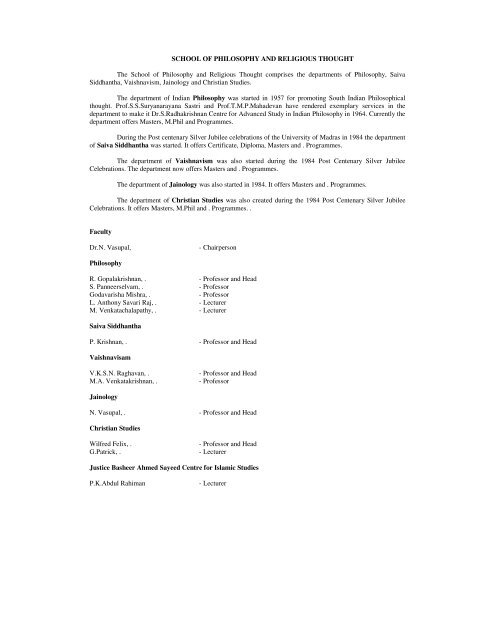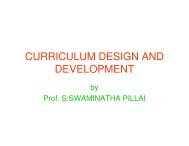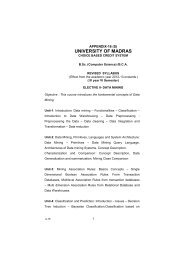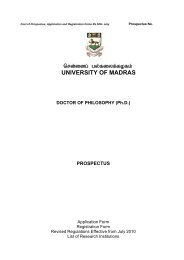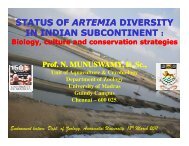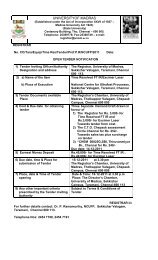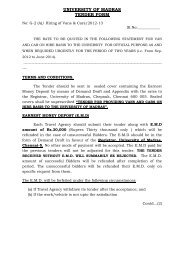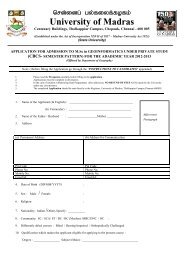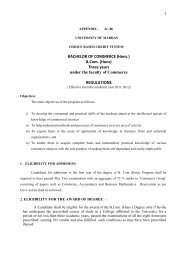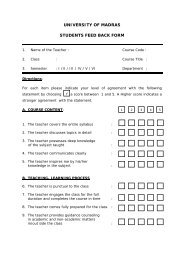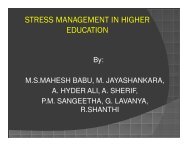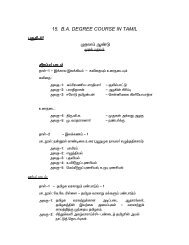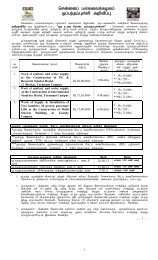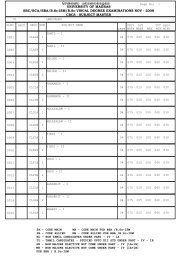School of Philosophy and Religious Thought - University of Madras
School of Philosophy and Religious Thought - University of Madras
School of Philosophy and Religious Thought - University of Madras
Create successful ePaper yourself
Turn your PDF publications into a flip-book with our unique Google optimized e-Paper software.
SCHOOL OF PHILOSOPHY AND RELIGIOUS THOUGHTThe <strong>School</strong> <strong>of</strong> <strong>Philosophy</strong> <strong>and</strong> <strong>Religious</strong> <strong>Thought</strong> comprises the departments <strong>of</strong> <strong>Philosophy</strong>, SaivaSiddhantha, Vaishnavism, Jainology <strong>and</strong> Christian Studies.The department <strong>of</strong> Indian <strong>Philosophy</strong> was started in 1957 for promoting South Indian Philosophicalthought. Pr<strong>of</strong>.S.S.Suryanarayana Sastri <strong>and</strong> Pr<strong>of</strong>.T.M.P.Mahadevan have rendered exemplary services in thedepartment to make it Dr.S.Radhakrishnan Centre for Advanced Study in Indian <strong>Philosophy</strong> in 1964. Currently thedepartment <strong>of</strong>fers Masters, M.Phil <strong>and</strong> Programmes.During the Post centenary Silver Jubilee celebrations <strong>of</strong> the <strong>University</strong> <strong>of</strong> <strong>Madras</strong> in 1984 the department<strong>of</strong> Saiva Siddhantha was started. It <strong>of</strong>fers Certificate, Diploma, Masters <strong>and</strong> . Programmes.The department <strong>of</strong> Vaishnavism was also started during the 1984 Post Centenary Silver JubileeCelebrations. The department now <strong>of</strong>fers Masters <strong>and</strong> . Programmes.The department <strong>of</strong> Jainology was also started in 1984. It <strong>of</strong>fers Masters <strong>and</strong> . Programmes.The department <strong>of</strong> Christian Studies was also created during the 1984 Post Centenary Silver JubileeCelebrations. It <strong>of</strong>fers Masters, M.Phil <strong>and</strong> . Programmes. .FacultyDr.N. Vasupal,- Chairperson<strong>Philosophy</strong>R. Gopalakrishnan, . - Pr<strong>of</strong>essor <strong>and</strong> HeadS. Panneerselvam, . - Pr<strong>of</strong>essorGodavarisha Mishra, .- Pr<strong>of</strong>essorL. Anthony Savari Raj, . - LecturerM. Venkatachalapathy, . - LecturerSaiva SiddhanthaP. Krishnan, . - Pr<strong>of</strong>essor <strong>and</strong> HeadVaishnavisamV.K.S.N. Raghavan, .M.A. Venkatakrishnan, .- Pr<strong>of</strong>essor <strong>and</strong> Head- Pr<strong>of</strong>essorJainologyN. Vasupal, . - Pr<strong>of</strong>essor <strong>and</strong> HeadChristian StudiesWilfred Felix, .G.Patrick, .- Pr<strong>of</strong>essor <strong>and</strong> Head- LecturerJustice Basheer Ahmed Sayeed Centre for Islamic StudiesP.K.Abdul Rahiman- Lecturer
M.A. PHILOSOPHYCOURSECODECOURSE TITLEC/E/SSCREDITSCOURSE FACULTYL T P CFirst SemesterPRT C001 Foundations <strong>of</strong> Indian <strong>Philosophy</strong> C 3 1 0 4 M. VenkatachalapathyPRT C002 Critical Appraisal <strong>of</strong> the <strong>Philosophy</strong> <strong>of</strong> C 2 1 0 3 G. MishraAdvaitaPRT C003 Logic C 2 1 0 3 S. PanneerselvamPRT C004 Contemporary Indian <strong>Philosophy</strong> C 3 1 0 4 L. Anthony Savari RajPRT E001 Indian <strong>Philosophy</strong> <strong>of</strong> Beauty E 2 1 0 3 R. GopalakrishnanPRT E002 <strong>Philosophy</strong> <strong>of</strong> Saint Ramalingar E 2 1 0 3 M. VenkatachalapathyPRT E003 <strong>Philosophy</strong> <strong>and</strong> Film E 2 1 0 3 S. PanneerselvamSecond SemesterPRT C005 Introduction to Hermeneutics C 2 1 0 3 S. PanneerselvamPRT C006 Sankara's Critique <strong>of</strong> other <strong>School</strong>s C 2 1 0 3 G. MishraPRT C007 Introduction to the <strong>School</strong>sC 2 1 0 3 R. Gopalakrishnan<strong>of</strong> SaivismPRT C008 Political <strong>Philosophy</strong> C 3 1 0 4 M. VenkatachalapathyPRT E004 Ecophilosophy E 2 1 0 3 L. Anthony Savari RajPRT E005 Ancient Indian Political <strong>Thought</strong> E 2 1 0 3 G. MishraPRT E006 Religion <strong>and</strong> <strong>Philosophy</strong> <strong>of</strong> the Tamils E 2 1 0 3 M. VenkatachalapathyThird SemesterPRT C009 Buddhism C 3 1 0 4 G. MishraPRT C010 Ancient <strong>and</strong> Modern WesternC 2 1 0 3 S. Panneerselvam<strong>Philosophy</strong>PRT C011 Intercultural <strong>Philosophy</strong> C 2 1 0 3 L. Anthony Savari RajPRT C012 Sivajnanabodham C 2 1 0 3 M. VenkatachalapathyPRT E007 <strong>Philosophy</strong> <strong>of</strong> Religion E 2 1 0 3 R. GopalakrishnanPRT E008 Neo-Buddhism E 2 1 0 3 G. MishraPRT S001 Self-study SS 3 All FacultyFourth SemesterPRT C013 Moral <strong>Philosophy</strong> C 3 1 0 4 R. GopalakrishnanPRT C014 Naiskarmyasiddhi (First Chapter) C 2 1 0 3 G. MishraPRT C015 Tractatus Logico-Philosophicus C 2 1 0 3 S. PanneerselvamPRT C016 Contemporary Western <strong>Philosophy</strong> C 2 1 0 3 L. Anthony Savari RajPRT C017 Hindu Social <strong>Philosophy</strong> C 2 1 0 3 M. VenkatachalapathyPRT E009 Social <strong>and</strong> Political <strong>Philosophy</strong> <strong>of</strong>E 2 1 0 3 M. VenkatachalapathyDr.B.R. AmbedkarPRT E010 Religion, Technology <strong>and</strong>E 2 1 0 3 L. Anthony Savari RajHuman LiberationPRT S002 Self-study SS 3 All FacultyPRT C001 Foundations <strong>of</strong> Indian <strong>Philosophy</strong> 3 1 0 4 Dr. M. VenkatachalapathyPRT C002 Critical Appraisal <strong>of</strong> the <strong>Philosophy</strong> <strong>of</strong> Advaita 2 1 0 3 Dr. G. MishraPRT C003 Logic 2 1 0 3 Dr. S. PanneerselvamPRT C004 Contemporary Indian <strong>Philosophy</strong> 3 1 0 4 Dr. L. Anthony Savari RajObjective:Contemporary Indian <strong>Philosophy</strong> differs in many ways from Classical Indian thought. While Classical Indianthought developed virtually without any outside influences, the stamp <strong>of</strong> the awareness <strong>of</strong> the West, its culture <strong>and</strong>its philosophy is evident in contemporary Indian thought. Besides a renewed interest in Advaita Vedanta, there isalso an attempt by the contemporary Indian thinkers at re-examining <strong>and</strong> reinterpreting the past to the socio-
political-cultural-religious context <strong>of</strong> our contemporary times. The course aims at introducing the student to thisrich fare <strong>of</strong> contemporary Indian thought in a panoramic way.Syllabus:1. Background, 2. Raja Ram Mohan Roy, Dayan<strong>and</strong> Sarasvati <strong>and</strong> Trends towards Revival, 3. Sri Ramakrishna,4. Swami Vivekan<strong>and</strong>a, 6. Rabindranath Tagore, 7. M.K. G<strong>and</strong>hi, 8. Aurobindo, 9. Mohammed Iqbal, 10. K.C.Battacharya, 11. Ambedkar, 12. Sarvepalli Radhakrishnan, 13. J. Krishnamurti , <strong>and</strong> 14. Raimon Panikkar.PRT E001 Indian <strong>Philosophy</strong> <strong>of</strong> Beauty 2 1 0 3 Dr. R. GopalakrishnanPRT E002 <strong>Philosophy</strong> <strong>of</strong> Saint Ramalingar 2 1 0 3 Dr. M. VenkatachalapathyPRT E003 <strong>Philosophy</strong> <strong>and</strong> Film 2 1 0 3 Dr. S. PanneerselvamThe objective <strong>of</strong> this course is to discuss philosophical ideas <strong>and</strong> themes from the perspective <strong>of</strong> films.Films can serve as a communicative medium to illuminate the philosophical arguments <strong>and</strong> ideas. Films whichrepresent social reality is influenced by different philosophical schools <strong>and</strong> movements.Unit 1:Unit 2Unit 3:Unit 4:Unit 5:The language <strong>of</strong> films-Cinematic language-How does it differ from ordinary language- Using theparadigm <strong>of</strong> Habermas’ communicative action to underst<strong>and</strong> the language <strong>of</strong> the films.:Film theories- the ontological <strong>and</strong> epistemological status <strong>of</strong> films- The social responsibility <strong>of</strong> the filmsin thecontemporary world-<strong>Philosophy</strong> as a guide to film world.Film as contemporary art –Realism <strong>and</strong> realism –surrealism in films in the background <strong>of</strong> philosophicalthinkers- Russell, Wittgenstein <strong>and</strong> Dummett.Film as the medium <strong>of</strong> education- human culture <strong>and</strong> values- Alienation in technological societyscientifichubris-Kurosawa’s films-Deleuze’s underst<strong>and</strong>ing <strong>of</strong> films- movement image <strong>and</strong> the timeimage.Films <strong>and</strong> National movement in India-Contribution <strong>of</strong> the Dravidian movement to films-Tradition <strong>and</strong>modernity in films- Evaluative study <strong>of</strong> the films- Pather Panchali-Elipathayam-Thanner Thanner-Azhagi <strong>and</strong> P<strong>and</strong>avar Boomi.PRT C005 Introduction to Hermeneutics 2 1 0 3 Dr. S. PanneerselvamPRT C006 Sankara's Critique <strong>of</strong> Other <strong>School</strong>s 2 1 0 3 Dr. G. MishraPRT C007 Introduction to the <strong>School</strong>s <strong>of</strong> Saivism 2 1 0 3 Dr. R. GopalakrishnanPRT C008 Political <strong>Philosophy</strong> 3 1 0 4 Dr. M. VenkatachalapathyPRT E004 Ecophilosophy 2 1 0 3 Dr. L. Anthony Savari RajObjective:The premise <strong>of</strong> this course is that the vocation <strong>of</strong> each human being is to be pro-human <strong>and</strong> pro-earth at the sametime. It underscores the view that the contemporary ecological crisis is not merely ecological <strong>and</strong> technical, but itis human <strong>and</strong> it requires a radical re-vision in the human attitude towards nature. The course explores, withinsights <strong>of</strong> various religious <strong>and</strong> cultural traditions, the field <strong>of</strong> interbeing, where all beings on earth make up onehousehold <strong>and</strong> which benefits from an economy that takes ecological <strong>and</strong> social intercommunication <strong>and</strong>interdependence seriously. The course also pays special attention to the emerginig ecosophical, ecopsychological,<strong>and</strong> ecosocial paradigms which indeed <strong>of</strong>fer a new <strong>and</strong> invigorating vision that may yet liberate us from thecontemporary, technical, globalizing, <strong>and</strong> self-destructive world-view.Syllabus:I. Ecology1. The Ecological Crisis <strong>and</strong> Ecologicial Consciousness2. The Need to go Beyond Ecology
II. Beyond Ecology: Ecosophy1. Ecology in a Holistic Vision <strong>of</strong> Reality2. Ecopsychological <strong>and</strong> Intercommunicatoin ParadigmsIII. Philosophical Perspectives1. A Change in our Pecepetion <strong>of</strong> the Eartha. Discovering the Life <strong>of</strong> the Earthb. Discovering the Wisdom <strong>of</strong> the Earth2. A Change in the Human's Self-underst<strong>and</strong>inga. A Re-vision in the Definition <strong>of</strong> <strong>Philosophy</strong>b. A Re-vision <strong>of</strong> Time <strong>and</strong> ProgressIV. Ecosophy or Ecojustice?: Ecophilosophy in the Indian ContextPRT E005 Ancient Indian Political <strong>Thought</strong> 2 1 0 3 Dr. G. MishraPRT E006 Religion <strong>and</strong> <strong>Philosophy</strong> <strong>of</strong> the Tamils 2 1 0 3 M. VenkatachalapathyPRT C009 Buddhism 3 1 0 4 Dr. G. MishraPRT C010 Ancient <strong>and</strong> Modern Western <strong>Philosophy</strong> 2 1 0 3 Dr. S. PanneerselvamObjective:Western philosophical thinking began in ancient Greece nearly three thous<strong>and</strong> years ago <strong>and</strong> it has sincedeveloped in extremely diverse <strong>and</strong> interesting directions. The aim <strong>of</strong> this course is to acquaint the student with itsbroad outlines from early Greek <strong>Philosophy</strong> to the <strong>Philosophy</strong> <strong>of</strong> Immanuel Kant.Syllabus:1. Introduction: Early Greek <strong>Philosophy</strong>, 2. Plato, 3. Aristotle, 4. St. Thomas Aquinas, 5. Descartes, 6.Spinoza, 7. Leibnitz, 8. Locke, 9. Berkeley, 10. David Hume, 11. Immanuel KantPRT C011 Intercultural <strong>Philosophy</strong> 2 1 0 3 Dr. L. Anthony Savari RajObjective:Probably every human culture has developed typical ways <strong>of</strong> philosophizing in the sense that there weregiven explanations <strong>of</strong> the world, <strong>of</strong> what man is, <strong>and</strong> <strong>of</strong> the right relationship between human beings. Amidst aperiod <strong>of</strong> globalization <strong>of</strong> many aspects <strong>of</strong> human life, the problem now arises, whether there will be one singleform or method <strong>of</strong> philosophy in the future. If so, must we give up the idea that philosophy ever can argue foruniversally accepted truths or insights? Addressing some aspects <strong>of</strong> these questions, this course aims to portrayintercultural philosophy as the endeavor to give expression to the manifold voices <strong>of</strong> philosophy in their respectivecontexts.Syllabus:I. Introduction1.The Context <strong>and</strong> Relevance <strong>of</strong> Intercultural <strong>Philosophy</strong> . Approaches to Intercultural <strong>Philosophy</strong>3. IsIntercultural <strong>Philosophy</strong> a New Branch or Orientation?II. The Clarification <strong>of</strong> Fundamental Concepts1. Culture, Cultural Diversity <strong>and</strong> Interculturality . <strong>Philosophy</strong> in Different Cultures: HomeomorphicEquivalentsIII. Foundation <strong>of</strong> Intercultural <strong>Philosophy</strong>1.In Search <strong>of</strong> a Common Language: Cross-Cultural Hermeneutics .A New <strong>and</strong> Pluralistic Vision <strong>of</strong>RealityIV. Proposals for Intercultural Dialogue in Different AreasV. Interculturality <strong>and</strong> Justice: Indian Lessons for Intercultural <strong>Philosophy</strong>
PRT C012 Sivajnanabodham 2 1 0 3 Dr. M. VenkatachalapathyPRT E007 <strong>Philosophy</strong> <strong>of</strong> Religion 2 1 0 3 Dr. R. GopalakrishnanPRT E008 Neo-Buddhism 2 1 0 3 Dr. G. MishraPRT S001 Self-study All FacultyPRT C013 Moral <strong>Philosophy</strong> 3 1 0 4 Dr. R. GopalakrishnanPRT C014 Naiskarmyasiddhi (First Chapter) 2 1 0 3 Dr. G. MishraPRT C015 Tractatus Logico-Philosophicus 2 1 0 3 Dr. S. PanneerselvamPRT C016 Contemporary Western <strong>Philosophy</strong> 2 1 0 3 Dr. L. Anthony Savari RajObjective:The purpose <strong>of</strong> this course is to give a brief presentation <strong>of</strong> the philosophy <strong>of</strong> western thinkers whoselives <strong>and</strong> reflections have indeed moulded our contemporary times. It will present the thinkers in terms <strong>of</strong> the mainschools, focusing attention one or two major representatives. The course also intends to make reflection <strong>and</strong>exchange on selected extracts from the major thinkers <strong>of</strong> the present-day western philosophical scene.Syllabus:1. Post-Kantian Idealism, 2. Positivism, 3. Pragmatism <strong>and</strong> Empirical Realism, 4. Logical Positivism <strong>and</strong>Analytic <strong>Philosophy</strong>, 5. Philosophies <strong>of</strong> Life <strong>and</strong> Phenomenology, 6. Structuralism, Post-Structualism <strong>and</strong>Hermeneutics, 7. Postmodernism.PRT C017 Hindu Social <strong>Philosophy</strong> 2 1 0 3 Dr. M. VenkatachalapathyPRT E009 Social <strong>and</strong> Political <strong>Philosophy</strong> <strong>of</strong> Dr.B.R. Ambedkar 2 1 0 3 Dr. M. VenkatachalapathyBharat Ratna' Dr. B. R. Ambedkar, was a great freedom fighter, Philosopher, Statesman, Writer, Orator,Constitutional expert, Educationist, Scholar albeit a veritable genius. And fought the whole <strong>of</strong> his life for thefreedom <strong>and</strong> uplift <strong>of</strong> the downtrodden, oppressed <strong>and</strong> suppressed classes. His struggle was against injustice <strong>and</strong>inequality in all spheres <strong>of</strong> life. He wanted equality in religious, social, economic <strong>and</strong> political matters for allclasses <strong>of</strong>fering them an opportunity to rise in life. Dr. Ambedkar was well aware that the major task is to alter theSocial Structure. He wanted equal status for women to spare them <strong>of</strong> the tyrannies <strong>and</strong> fortitudes <strong>of</strong> tradition.SYLLABUSUnit 1: Introduction: A short life sketch <strong>of</strong> Dr. B. R. Ambedkar; Philosophical background for Ambedkar'svision <strong>and</strong> mission; Buddhism as means to Social Revolution.Unit 2: Dr. Ambedkar's ideas on Vedic Social <strong>and</strong> Philosophical tradition; Sanadhana dharma – Varnashramadharma – Caste system as a Political power – who are the Sudras.Unit 3 :Social Justice <strong>and</strong> Right to Equality; Meaning <strong>and</strong> Concept <strong>of</strong> Social Justice <strong>and</strong> its historicalperspectives – Theories <strong>of</strong> Justice <strong>and</strong> Social Justice – Social Justice <strong>and</strong> Abolition <strong>of</strong> Untouchability –Social justice <strong>and</strong> Freedom <strong>of</strong> Religion – Concept <strong>and</strong> meaning <strong>of</strong> Equality – Social equality.Unit 4: Social justice <strong>and</strong> Right against Exploitation – Bonded Labour System – Social justice to Minority,Women, Children, Labour – Uniform civil code.Unit 5: Dr. Ambedkar's contribution to Indian Political <strong>and</strong> Constitutional thought – Role as a Chairman inConstitution drafting committee – Independency <strong>of</strong> Judiciary – Caste system <strong>and</strong> Parliamentarydemocracy <strong>and</strong> economic democracy – Social justice through reservation – Political <strong>and</strong> Social strategiesfor Dalit upliftment.PRT E010 Religion, Technology <strong>and</strong> Human Liberation 2 1 0 3 Dr. L. Anthony Savari RajObjective:While traditional religions claim to liberate people from bondage, modern technology purports also t<strong>of</strong>ree the human beings from the shackles <strong>of</strong> Nature. A study <strong>of</strong> the mutual relationship <strong>and</strong> critical analysis <strong>of</strong> bothclaims forms the subject matter <strong>of</strong> this course.Syllabus:
Introduction: The Contemporary Scene: The Predominant (technocratic) WorldviewI. What is Human Liberation?1. The Different Concepts <strong>of</strong> Salvation in the World Religions 2. '<strong>Religious</strong>' Liberation from <strong>and</strong>'Political' Liberation to? . The Meaning <strong>of</strong> Human LiberationII. The Nature <strong>of</strong> Technology1. Technology <strong>and</strong> Culture 2. The Difference Between Techne <strong>and</strong> Technology (Art <strong>and</strong> Technology) 3.Some Special Traits <strong>of</strong> TechnologyIII. Liberation <strong>and</strong> Technology1. The Technocratic Society 2. Liberation <strong>and</strong> Technology 3. Emancipation from TechnologyPRT S002 Self-study All FacultyM.A.COMPARATIVE RELIGION AND PHILOSOPHY WITH SPECIALISATION IN SAIVASIDDHANTASubject Code Title <strong>of</strong> the course C/E CreditsL T P CPRT C401SEMESTER IHistory <strong>of</strong> Saiva Siddhanta C 3 1 0 4PRT C402 Saiva <strong>School</strong>s C 3 1 0 4PRT C403 Epistemology C 3 1 0 4PRT E401 Mind <strong>and</strong> Meditation:J. Krishnamuti E 2 1 0 3PRT E402 Yoga <strong>of</strong> Patanjali E 2 1 0 3SEMESTERIIPRT C404 Foundational Concepts <strong>of</strong> Metaphysics C 3 1 0 4PRT C405 <strong>Philosophy</strong> <strong>of</strong> God (Pati) C 3 1 0 4PRT C406 <strong>Philosophy</strong> <strong>of</strong> Soul(Pasu) C 3 1 0 4PRT E403 Liberation: Saiva Siddhanta E 2 1 0 3PRT E404 Wisdom & Compassion: Nagarjuna E 2 1 0 3SEMESTER IIIPRT C407 Essentials <strong>of</strong> Saiva Siddhanta C 2 0 0 2PRT C408 Nature <strong>of</strong> the External World C 3 1 0 4PRT C409 Bondage <strong>and</strong> liberation C 3 1 0 4PRT C410 Readings from Mapadiam C 3 1 0 4PRT E405 Meditation: Zen E 2 1 0 3PRT E406 <strong>Philosophy</strong> <strong>of</strong> St. Ramalinga E 2 1 0 3SEMESTER IVPRT C411 Sivajnanabodham: Vadivelu Chettiar Commentary C 3 1 0 4PRT C412 Sivaprakasam C 3 1 0 4PRT C413 Essentials <strong>of</strong> Indian <strong>Philosophy</strong> C 3 1 0 4PRT C414 Tiruvarutpayan C 2 1 0 3PRT E407 Tirum<strong>and</strong>iram E 2 1 0 3PRT C401 History <strong>of</strong> Saiva Siddhanta C 3 1 0 4 GuestFacultyThis course sketches briefly the history <strong>of</strong> Saivism from the Vedas to the Siddhanta Sastras. Indus ValleyCivilization, Upanisads, Saivagamas, Tolkappiyam <strong>and</strong> Sangam literature the works <strong>of</strong> Samayacaryas areexplained as l<strong>and</strong>marks in the development <strong>of</strong> Saiva Siddhanta, Contributions <strong>of</strong> Kumara Gurubarar,Arunagirinathar <strong>and</strong> Thayumanavar-Saiva Mutts.PRT C402 Saiva <strong>School</strong>s C 3 1 0 4 GuestFacultyKashmir Saivism, Sivadvaita <strong>and</strong> Vira Saivism are the schools covered under this course. UnderKashmir Saivism, the concept <strong>of</strong> Absolute <strong>and</strong> its manifestation, Concept <strong>of</strong> Self, bondage <strong>and</strong> liberation are dealtwith. Sivadvaita’s concept <strong>of</strong> Absolute, the world <strong>and</strong> the self are explained. Under Vira Saivism, the concept <strong>of</strong>Linga, Sakti, Anga, Bhakti, Pancacara, Ashtavarna, Satsthala are expounded.
PRT C403 Epistemology C 3 1 0 4 P.KrishnanPramana – prameya – prama – pramada - Theories <strong>of</strong> extrinsic <strong>and</strong> intrinsic, validity-pragmatic,coherence <strong>and</strong> correspondence theories <strong>of</strong> truth – Siddhantic theory as both extrinsic <strong>and</strong> intrinsic – Atma-citsaktias ultimate pramana – Soul as knower in bondage <strong>and</strong> liberation – Siddhanta concept <strong>of</strong> error in the context <strong>of</strong>other Indian theories - Elements <strong>of</strong> rationalism <strong>and</strong> Empiricism.PRT E401 Mind <strong>and</strong> Meditation:J. Krishnamuti E 2 1 0 3 P.KrishnanThe purpose <strong>of</strong> the course is to enable the students to be self-critical <strong>and</strong> creative. Beliefs - you are theworld – separation - violence – the art <strong>of</strong> seeing – peaceful mind – Truth - choiceless awareness – Reality –Freedom – Love - compassion are explained.PRT E402 Yoga <strong>of</strong> Patanjali E 2 1 0 3 P.KrishnanThis course deals with the following; Nature <strong>of</strong> Purusa <strong>and</strong> Prakrti, Yama, Niyama, Asana, Pranayama,Pratyahara, Dharana, Dhyana <strong>and</strong> Samadhi – Samprajnata Samadhi <strong>and</strong> Asamprajnata Samadhi, Isvarapranidhana,Cita-vrtti- nirodha <strong>and</strong> Kaivalya - cognition without the cogniser <strong>and</strong> the cognized.PRT C404 Foundational Concepts <strong>of</strong> Metaphysics C 3 1 0 4 Guest FacultyEvolution (sopana) – Classification <strong>of</strong> scriptural texts <strong>and</strong> philosophical schools – Siddhanta as systempar excellence – Kramamukti – Concepts <strong>of</strong> Advaita – Kevaladvaita –Visistadvaita, Suddhadvaita (Vyapaka –vyapya samb<strong>and</strong>ha). Theory <strong>of</strong> causality – Satkaryavada – discussed in the context <strong>of</strong> other theories.PRT C405 <strong>Philosophy</strong> <strong>of</strong> God (Pati) C 3 1 0 4 P.KrishnanArguments for the existence <strong>of</strong> God discussed in the context <strong>of</strong> western theories – cosmologicalargument – moral argument – Ontological <strong>and</strong> teleological argument – Kant’s critique – essential <strong>and</strong> accidentalqualities – five – fold function <strong>of</strong> God as divine providence.PRT C406 <strong>Philosophy</strong> <strong>of</strong> Soul(Pasu) C 3 1 0 4 P.KrishnanArguments for the existence <strong>of</strong> the soul- plurality <strong>of</strong> souls – essential <strong>and</strong> accidental qualities – relationwith god <strong>and</strong> world – kevala, sakala <strong>and</strong> suddha asvasthas. Compared with that <strong>of</strong> Advaita <strong>and</strong> Visistadvaita.PRT E403 Liberation: Saiva Siddhanta E 2 1 0 3 Guest FacultyThis course briefly deals with the nature <strong>of</strong> soul, anava, karma <strong>and</strong> maya; the means for liberationbhakti<strong>and</strong> jnana yoga – liberated state..PRT E404 Wisdom & Compassion: Nagarjuna E 2 1 0 3 P.KrishnanAccording to Nagarjuna, the ultimate goal <strong>of</strong> human life is to attain wisdom <strong>and</strong> compassion(Mahaprajna <strong>and</strong> Mahakaruna). All beliefs are false- Catuskoti as a method is explained.PRT C407 Essentials <strong>of</strong> Saiva Siddhanta C 2 0 0 2 Guest FacultyThis course briefly deals with the nature <strong>of</strong> God, man, bondage <strong>and</strong> liberation.PRT C408 Nature <strong>of</strong> the External World C 3 1 0 4 Guest FacultyCreation- Brahmaparinama vada – Vivartavada – Prakrti parinamavada – concept <strong>of</strong> maya – Evolutes <strong>of</strong>Maya – Pluralistic Realism.PRT C409 Bondage <strong>and</strong> liberation C 3 1 0 4 Guest FacultyConcept <strong>of</strong> Anava as external – sahajamala – maya <strong>and</strong> karma as relative bondages-problem <strong>of</strong> free will<strong>and</strong> determinism, Siddhantic solution – means for liberation – liberated condition <strong>of</strong> the soul. Siddhantic theory isdiscussed with that <strong>of</strong> Advaita <strong>and</strong> Visistadvaita.
PRT C410 Readings from Mapadiam C 3 1 0 4 Guest FacultySivajnanabodha Mapadiam is an exemplary commentary on the Sivajnanabodham. The philosophy <strong>of</strong>Saiva Siddhanta as expounded in the Cirappupayiram, Mangalavalthu <strong>and</strong> Avai adakkam <strong>of</strong> Mapadiam is dealtwith.PRT E405 Meditation: Zen E 2 1 0 3 P.KrishnanThe purpose <strong>of</strong> the course is to give a comprehensive underst<strong>and</strong>ing <strong>of</strong> Zen. Bodhidharma – Dhyana –Chan (China) – Zen (Japan) – Soto <strong>School</strong> <strong>and</strong> Rinzai <strong>School</strong>: Koan <strong>and</strong> Zazen techniques <strong>of</strong> meditation areexpounded.PRT E406 <strong>Philosophy</strong> <strong>of</strong> St. Ramalinga E 2 1 0 3 Guest FacultyThis course deals with the following: the place <strong>of</strong> Ramalinga in the religious <strong>and</strong> philosophical history <strong>of</strong>Tamilnadu, Samarasa suddha sanmargam, compassion as the key <strong>of</strong> moksa, satya dharma sabai, siddhivalagam,suddha deham, pranava deham, jnana deham <strong>and</strong> immortal life.PRT C411 Sivajnanabodham: Vadivelu Chettiar Commentary C 3 1 0 4 Guest FacultyVadivelu Chettiar has interpreted the twelve sutras <strong>of</strong> Sivajnana bodham in the light <strong>of</strong> Sankara’sAdvaita Vedanta. The method <strong>of</strong> interpretation, the concept <strong>of</strong> Siva as Brahma, Maya, Avidya , the nature <strong>of</strong> selfas identical with Brahman, means to release <strong>and</strong> other related concepts are explained by closely following thecommentary.PRT C412 Sivaprakasam C 3 1 0 4 Guest FacultyAfter briefly describing the background, chronology <strong>and</strong> the content <strong>of</strong> the fourteen Meyk<strong>and</strong>asastras,this course makes a detailed study <strong>of</strong> Umapati Sivam’s Sivaprakasam. The structure <strong>of</strong> the text, the methods <strong>of</strong>general <strong>and</strong> special <strong>and</strong> the uniqueness in expounding the philosophy <strong>of</strong> Siddhanta are dealt with. The concept <strong>of</strong>atmadarshana, atmasuddhi, atmalabham, upaya nistha <strong>and</strong> jnana nistha are elucidated.PRT C413 Essentials <strong>of</strong> Indian <strong>Philosophy</strong> C 3 1 0 4 P.KrishnanThe tradition <strong>of</strong> Indian <strong>Philosophy</strong> – Vaidika <strong>and</strong> Avaidika – basic features <strong>of</strong> metaphysics,epistemology <strong>and</strong> ethics <strong>of</strong> Nyaya. Vaisesika, Sankhya, Yoga, Mimamsa. Vedanta, Jainism, Buddhism <strong>and</strong>Carvaka.PRT C414 Tiruvarutpayan C 2 1 0 3 Guest FacultyThe philosophy <strong>of</strong> Siddhanta as set forth in the following 3 chapters are dealt with: 1..Patimudhu Nilai,2, Uyir avai Nilai <strong>and</strong> 3.Irul Mala Nilai .PRT E407 Tirum<strong>and</strong>iram E 2 1 0 3 Guest FacultyThis course deals with the philosophy <strong>and</strong> ethics as expounded in the first tantra <strong>of</strong> Tirum<strong>and</strong>iram, thetenth devotional canonical literature <strong>of</strong> Saiva Siddhanta. Pati – Pasu - Pasa – Doctrine <strong>of</strong> Impermanence – Yoga –Siddha – Siva Siddha are explained.
M.A.COMPARATIVE RELIGION AND PHILOSOPHY WITH SPECIALISATION IN VAISHNAVISMSub Code Title <strong>of</strong> the course C/E CreditsFIRST SEMESTER L T P CPRT C201 Historical Development <strong>of</strong> Vaishnavism – I C 3 1 0 4PRT C202 Early Tamil Texts in Vaishnavism C 3 1 0 4PRT C203 Hymns <strong>of</strong> Tirumangai Alvar C 3 1 0 4PRT E201 Early Sanskrit Texts in Vaishnavism E 2 1 0 3SECOND SEMESTERPRT E202 Basic Sanskrit for <strong>Philosophy</strong> E 2 1 0 3PRT C204 Historical Development <strong>of</strong> Vaishnavism-II C 3 1 0 4PRT C205 Rahasya Granthas <strong>of</strong> Lokacharya & Nayanar C 3 1 0 4PRT C206 <strong>School</strong>s <strong>of</strong> Vaishnavism – I C 3 1 0 4PRT E203 Sanskrit Stotra Literature in Vaishnavism E 2 1 0 3PRT E204 Srivaishnava Agamas & Temple Festivals E 2 1 0 3THIRD SEMESTERPRT C207 Essentials <strong>of</strong> Vaishnavism C 3 1 0 4PRT C208 Doctrines <strong>of</strong> Visishtadvaita C 3 1 0 4PRT C209 <strong>School</strong>s <strong>of</strong> Vaishnavism - II C 2 1 0 3PRT C210 Hymns <strong>of</strong> Nammalvar C 3 1 0 4PRT E205 Special Tamil Texts in Vaishnavism E 2 1 0 3FOURTH SEMESTERPRT C211 Basic Texts in Visishtadvaita C 3 1 0 4PRT C212 Rahasya Granthas <strong>of</strong> Vedanta Desika C 3 1 0 4PRT C213 Tamil Stotra Literature in Vaishnavism C 2 1 0 3PRT E206 Special Sanskrit Texts in Vaisnavism E 2 1 0 3MASTERS COURSES ABSTRACTPRT C201 Historical Development <strong>of</strong> Vaishnavism – I C 3 1 0 4 V .K.S.N RaghavanThe concept <strong>of</strong> Vishnu in association with Sri can be traced to the Vedas, Purushasukta, Srisukta,Upanishads, the Epics (Ramayana <strong>and</strong> Mahabharata), the Puranas <strong>and</strong> the Agamas. The Tamil mystic saints Alvarsbrought a renaissance <strong>of</strong> the Bhakti movement. This inspired the line <strong>of</strong> Acharyas beginning with Nathamuni. TheUbhayavedanta tradition probably started with him. Other important Acharyas like Yamuna, Ramanuja,Kuresvara, Parasara, Pillai Lokacharya, Vedanta Desika <strong>and</strong> Manavalamamuni systematised the SrivaishnavaReligion <strong>and</strong> <strong>Philosophy</strong>. The contributions <strong>of</strong> the Acharyas up to Sri Ramanuja are discussed in this course.PRT C202 Early Tamil Texts in Vaishnavism C 3 1 0 4 M.A.Vengata KrishnanThe Sangam Literature in Tamil deals with - among other things - the greatness <strong>and</strong> supremacy <strong>of</strong> LordVishnu (Thirumal) <strong>and</strong> his Avataras (incarnations). The Paripadal songs (forming part <strong>of</strong> Sangam Literature)highlight ways <strong>and</strong> means to reach God. Paripadal songs 1,2,3,4, 13 & 15 are prescribed for study in this course.PRT C203 Hymns <strong>of</strong> Tirumangai Alvar C 3 1 0 4 M.A.VenkatakrishnanThe Alvars are Divine saint-poets who have propagated Srivaishnavism by their soul-stirring songs.These songs have been compiled by Nathamuni <strong>and</strong> the compendium is known as Nalayira Divyaprab<strong>and</strong>ham(Four thous<strong>and</strong> Divine Hymns). Among the Alvars, Tirumangai Alvar who is next only to Nammalvar inimportance has composed six works. Periya Tirumoli 1-1, 5-8, 11-8, Siriya Tirumadal, <strong>and</strong> Tirunedunth<strong>and</strong>agam<strong>of</strong> Tirumangai Alvar are prescribed for study in this course.PRT E204 Early Sanskrit texts in Vaishnavisam E 2 1 0 3 VKSN RaghavanAmong the important ancient Sanskrit texts <strong>of</strong> Vaishnavism the Purusha Suktam, Sri Suktam, <strong>and</strong> theIsavasyopanishad point out the supremacy <strong>of</strong> Lord Vishnu <strong>and</strong> Goddess Lakshmi. This course <strong>of</strong>fers a detailedstudy <strong>of</strong> the above texts.
PRT E202 Basic Sanskrit for <strong>Philosophy</strong> E 2 1 0 3 VKSN RaghavanAmong the classical languages <strong>of</strong> the world, Sanskrit is hailed as one <strong>of</strong> the most ancient languages.Many <strong>of</strong> the important terms in the Indian philosophical systems are mainly based on Sanskrit language. Theimportant philosophical terms will be explained after imparting basic knowledge in Sanskrit to the students. Thiscourse fulfils the needs <strong>of</strong> students <strong>of</strong> philosophy.PRT C204 Historical Development <strong>of</strong> Vaishnavism-II C 3 1 0 4 VKSN RaghavanThe post-Ramanuja period in the history <strong>of</strong> Srivaishnavism saw the emergence <strong>of</strong> two branches calledthe Thenkalai <strong>and</strong> the Vadagalai represented by Pillai Lokacharya <strong>and</strong> Vedanta Desika respectively. Thecontributions <strong>of</strong> the Acharyas <strong>of</strong> the post-Ramanuja period, the role played by the 74 Simhasanadhipathis inspreading the Ubhayavedanta tradition - the establishment <strong>of</strong> various Mathas for safeguarding <strong>and</strong> propagating theRamanuja (Emberumanar) Darsana are discussed in this course.PRT C205 Rahasya Granthas <strong>of</strong> Lokacharya & Nayanar C 3 1 0 4 M.A.VenkatakrishnanThe esoteric texts or technical literature <strong>of</strong> Srivaishnavism are called Rahasya Granthas. Pillai Lokacharya<strong>and</strong> Alagiyamanavala Perumal Nayanar have composed several Rahasya Granthas in Manipravala style. Selectportions <strong>of</strong> their works are prescribed for study in this course.PRT C206 <strong>School</strong>s <strong>of</strong> Vaishnavism – I C 3 1 0 4 VKSN RaghavanThere are many schools <strong>of</strong> Vaishnavism like Dvaita Vedanta <strong>of</strong> Madhva, Suddhadvaita <strong>of</strong> Vallabha <strong>and</strong>Dvaitadvaita <strong>of</strong> Nimbarka. These systems will be briefly explained <strong>and</strong> the influence <strong>of</strong> Ramanuja on them willalso be assessed.PRT E203 Sanskrit Stotra Literature in Vaishnavism E 2 1 0 3 M.A.VenkatakrishnanStotras form part <strong>of</strong> the Vedic <strong>and</strong> classical Literatures in Sanskrit. The Vaishnava stotra literature bringsout the supremacy <strong>of</strong> Lord Narayana, the greatness <strong>of</strong> Goddess Lakshmi, the means (upaya) <strong>and</strong> the end (upeya) orthe summum bonum (moksha) <strong>of</strong> Life. Some important stotras viz. Jitante Stotra, Ranganatha-ashtaka <strong>of</strong> Sankara,Catuhsloki <strong>of</strong> Yamuna, Saranagati Gadya <strong>of</strong> Ramanuja, Sristuti <strong>of</strong> Vedanta Desika are prescribed for study.PRT E204 Srivaishnava Agamas & Temple Festivals E 2 1 0 3 M.A.VenkatakrishnanAgamas as contrasted with Nigamas (Vedas) may be called "<strong>Religious</strong> Texts". They deal in general withthe specifics about the construction <strong>of</strong> temples, preparation <strong>of</strong> images, installation <strong>of</strong> images, conduct <strong>of</strong> rituals <strong>and</strong>Temple Festivals. The Srivaishnava Agamas have two branches, viz., Pancharatra <strong>and</strong> Vaikhanasa. All theVaishnavite temples normally follow either <strong>of</strong> these two traditions <strong>of</strong> worship. The present course provides detailsabout the origin <strong>and</strong> development <strong>of</strong> these two Agama branches <strong>and</strong> their distinguishing features etc.PRT C207 Essentials <strong>of</strong> Vaishnavism C 3 1 0 4 M.A.VenkatakrishnanFundamental principles <strong>of</strong> Vaishnavism will be explained based on the Yatindramata Deepika <strong>of</strong>Srinivasa Dasa.PRT C208 Doctrines <strong>of</strong> Visishtadvaita C 3 1 0 4 VKSN RaghavanExplanation <strong>of</strong> the role <strong>of</strong> Prasthanatraya - Interpretation <strong>of</strong> the term Visishtadvaita as the name <strong>of</strong> thesystem - the supremacy <strong>of</strong> Lord Narayana - the basic tenets <strong>of</strong> the system like the Tattvatraya, Rahasyatraya,Arthapanchaka - the body-soul relationship between the Lord <strong>and</strong> the Universe - The concept <strong>of</strong> Sri <strong>and</strong> otherimportant principles <strong>of</strong> the philosophy <strong>of</strong> Visishtadvaita will be dealt with in this course.PRT C209 <strong>School</strong>s <strong>of</strong> Vaishnavism - II C 2 1 0 3 VKSN RaghavanThe other schools <strong>of</strong> Vaishnavism like Janakivallabha Sampradaya <strong>of</strong> Raman<strong>and</strong>a, AchintyaBhedabheda <strong>of</strong> Chaitanya, <strong>and</strong> Navya Visishtadvaita <strong>of</strong> Svami Narayana will be briefly explained <strong>and</strong> theinfluence <strong>of</strong> Ramanuja on them will also be assessed.
PRT C210 Hymns <strong>of</strong> Nammalvar C 3 1 0 4 M.A.VenkatakrishnanThe Alvars are Divine saint-poets who have propagated Srivaishnavism by their soul-stirring songs.These songs have been compiled by Nathamuni <strong>and</strong> the compendium is known as Nalayira Divyaprab<strong>and</strong>ham(Four thous<strong>and</strong> Divine Hymns). Among the Alvars, Nammalvar is hailed as "Prapannajanakutastha". His fourdivine compositions are considered as the essence <strong>of</strong> the four Vedas. Among them, the Tiruvaymoli consisting <strong>of</strong>1102 verses in 100 decades is the magnum opus <strong>of</strong> Nammalvar. It is considered to be the essence <strong>of</strong> Samaveda <strong>and</strong>hailed as Dravida Veda. Select decades from the Tiruvaymoli (known as Koyil Tiruvaymoli) are prescribed for thiscourse.PRT E205 Special Tamil Texts in Vaishnavism E 2 1 0 3 M.A.VenkatakrishnanThere are important texts in the form <strong>of</strong> Tamil hymns in Srivaishnavism. Among them RamanujaNutr<strong>and</strong>adi (verses 1-20), Jnana Saram & Prameya Saram <strong>of</strong> Arulalapperumal Emberumanar, Sapthakathai <strong>of</strong>Vilanjolaippillai, Paramapada Sopanam <strong>of</strong> Vedanta Desika <strong>and</strong> Upadesa Rathinamalai <strong>of</strong> Manavala Mamunigal(Verses 34-73) are prescribed for study.PRT C211 Basic Texts in Visishtadvaita C 3 1 0 4 M.A.VenkatakrishnanThe important principles <strong>of</strong> Visishtadvaita <strong>Philosophy</strong> will be discussed with the help <strong>of</strong> text books likeGitarthasangraha <strong>of</strong> Yamunacharya <strong>and</strong> Gita Bhasya (Chapters 7 & 9) <strong>of</strong> Ramanuja.PRT C212 Rahasya Granthas <strong>of</strong> Vedanta Desika C 3 1 0 4 VKSN RaghavanVedanta Desika, who has contributed more than hundred works, has composed 32 Rahasya Granthas inManipravala style. Anjali Vaibhavam, Sampradaya Parisuddhi <strong>and</strong> a few Adhikaras <strong>of</strong> Rahasyatrayasara areprescribed for study in this course.PRT C213 Tamil Stotra Literature in Vaishnavism C 2 1 0 3 VKSN RaghavanThe songs on Lord Vishnu in Tamil are unique in literary <strong>and</strong> philosophical contents. They areefficacious in achieving good things both secular <strong>and</strong> spiritual. Among the well-known passages AaychiyarKuravai (from Silappadikaram) <strong>and</strong> select songs from Kamba Ramayanam (Viraadan Thudi) <strong>and</strong> BharathiyarPadalgal (Kannan Padalgal) will be subjected to a detailed exposition in this course.PRT E206 Special Sanskrit Texts in Vaisnavism E 2 1 0 3 VKSN RaghavanThere are many important Sanskrit texts in Srivaishnavism. Among them Sri Vaikuntha Gadya <strong>of</strong>Ramanuja, Ashtasloki <strong>of</strong> Parasara Bhatta, Nyasa Dasakam & Nyasa Vimsati <strong>of</strong> Vedanta Desika, VaravaramuniDinachari <strong>of</strong> Devarajaguru are prescribed for study
M.A.COMPARATIVE RELIGION AND PHILOSOPHYSPECIALISATION IN JAINOLOGYSubject Code Title <strong>of</strong> the course C/E CreditsL T P CSEMESTER 1PRT C301 History <strong>of</strong> the Jaina Agamas C C 3 1 0 4PRT C302 Study <strong>of</strong> Jaina Scriptural Text I – Acharangasutra C C 3 1 0 4PRT C303 Jaina Ethics-Shravakachara <strong>and</strong> Muniachara C C 3 1 0 4PRT E301 History <strong>of</strong> Jainism E E 2 1 0 3PRT E302 Meditation <strong>and</strong> Personality Development E E 2 1 0 3PRT C304SEMESTER 11Jaina Metaphysics C C 3 1 0 4PRT C305 Study <strong>of</strong> Jaina Scriptural Text II – Panchastikayasara C C 3 1 0 4.PRT C306 Outlines <strong>of</strong> Indian <strong>Philosophy</strong> C C 3 1 0 4PRT E303 Jaina Saints <strong>and</strong> Spirituality E E 2 1 0 3PRT E304 Human Rights <strong>and</strong> Ethics E E 2 1 0 3PRT C307SEMESTER 11I (*)Jaina Epistemology (Logic) C C 3 1 0 4PRT C308 Study <strong>of</strong> Uttaradhyayanasutra C C 3 1 0 4PRT C309 Study <strong>of</strong> Tattvarthasutra C C 3 1 0 4PRT E305 Jainism in Tamilnadu E E 2 1 0 3PRT E306 Jainism <strong>and</strong> Indian Culture E E 2 1 0 3SEMESTER 1V (**)PRT C310 Essentials <strong>of</strong> Jainism C C 2 0 0 2PRT C311 Introduction to Prakrit C C 3 1 0 4PRT C312 Comparative Study <strong>of</strong> PhilosophicalC C 3 1 0 4Concepts.PRT C313 Jaina Yoga <strong>and</strong> Sadhana C C 3 1 0 4PRT C314 Dissertation – Optional C 6 0 0 6(*) The core courses in the third semester also include “Essentials <strong>of</strong> Saiva Siddhanta” <strong>and</strong> “Essentials <strong>of</strong>Vaishnavism” <strong>of</strong>fered by the respective Departments.(**) The core courses in the fourth semester also include “Essentials <strong>of</strong> Christianity” <strong>of</strong>fered by theDepartment <strong>of</strong> Christian Studies.JAINOLOGYCourse Code Course Title Core/Elective/Supportive/Self-StudyPRT C301History <strong>of</strong> the JainaAgamasCreditsL T P TotalThe main basis for the everlastingness <strong>of</strong> any Dharma is its scriptures. In scriptures all those fundamentalprinciples are treasured, upon which the massive manson <strong>of</strong> Dharma rests. The principle literature <strong>of</strong> Jainism isavailable in the form <strong>of</strong> Agamas viz., scriptures. Agamas are the collection <strong>of</strong> doctrines by personages whoseknowledge has become absolutely pure with the removal <strong>of</strong> impure karmic layers <strong>and</strong> has become doubtless <strong>and</strong>non-contradictory. This paper deals with the study <strong>of</strong> all the important Agamas <strong>of</strong> Jainism.Unit I Introduction to Agama Literature – Purva, AngasUnit II Upangas, PainnasUnit III Cheya suttas, Mulasuttas – N<strong>and</strong>i <strong>and</strong> AnuyogaddaraUnit IV The commentaries on Agamas, Redaction <strong>of</strong> AgamasUnit V Commentary on Shatkh<strong>and</strong>agama, Kashaya Pahuda, Successive Commentaries on these works –Dhavala <strong>and</strong> JayadhavalaCourseFacultyCore 4 1 0 5 GuestLecturerPRT C302 Study <strong>of</strong> the Jaina Scriptural Text I - Acharangasutra Core 3 1 0 4 Guest LecturerAcharangasutra unanimously occupies the prime position amongst the entire Jaina canon.Acharangasutra has got such an importance as Rigveda has got in Hinduism <strong>and</strong> Vinaya Pitaka in Buddhism. Thelanguage used in this scripture is the most ancient among the Prakrit. The subject matter <strong>of</strong> this course is to studythe different aspects <strong>of</strong> violence <strong>and</strong> non-violence as stated in Acharangasutra.
Text prescribed for study :Acharangasutra – Prathamashruta sk<strong>and</strong>ha,– Edited by Muni Shree Jambuvijayaji, Mahavira JainaVidyalaya, Bombay.Unit IUnit IIUnit IIIUnit IVUnit VIntroduction to Acharanga Sutra <strong>and</strong> Chapter IChapters II <strong>and</strong> IIIChapters IV <strong>and</strong> VChapters VI <strong>and</strong> VIIChapters VIII <strong>and</strong> IXPRT C303 Jaina Ethics – I Shravakachara Core 3 1 0 4 N.VasupalAll great religions <strong>of</strong> the world have laid great stress on morality as a vital factor regulating the conduct<strong>of</strong> an individual for his own good as also for the well-being <strong>of</strong> the society. Jainism is a <strong>Philosophy</strong> <strong>of</strong> ethicalrealism <strong>and</strong> has prescribed a specific code <strong>of</strong> conduct both for the householders (Shravaka) <strong>and</strong> the ascetic (Muni).This course deals with the study <strong>of</strong> the conduct <strong>of</strong> laity <strong>and</strong> ascetic.Unit IUnit IIUnit IIIUnit IVUnit VRatnatraya <strong>and</strong> Vratas-5 Mahavratas <strong>and</strong> 12 AnuvratasMulagunas <strong>of</strong> Sravaka <strong>and</strong> MuniPratimas <strong>of</strong> Sravaka <strong>and</strong> MuniDasalakshana Dharma/22 ParishahasAticharas <strong>and</strong> SallekhanaPRT E301 History <strong>of</strong> Jainism Elective 2 1 0 3 N.VasupalThe aim <strong>of</strong> this course is to study the historicity <strong>and</strong> the antiquity <strong>of</strong> Jainism. The Jaina traditionmaintains that Jainism is the eternal religion preached by Tirthankaras from time to time according to theexigencies <strong>of</strong> the social <strong>and</strong> spiritual needs <strong>of</strong> the people. Jainism is a pre-historic religion which prevailed in Indialong before Tirthankaras Mahavira <strong>and</strong> Parsva, the last two <strong>of</strong> the 24 Tirthankaras. The description about theconcept <strong>of</strong> Kalachakra, Kulakaras <strong>and</strong> the life <strong>and</strong> teachings <strong>of</strong> the Tirthankaras are to be dealt with in this course.Unit I Antiquity <strong>of</strong> JainismUnit II Concept <strong>of</strong> Kalachakra <strong>and</strong> Traditional account <strong>of</strong> KulakarasUnit III History <strong>of</strong> Tirthankaras – RishabhaUnit IV Neminatha, ParsvananathaUnit V MahaviraPRT E302 Meditation <strong>and</strong> Personality Development Elective 2 1 0 3 Guest Lecturer\This course enables the students to reflect on various world situations <strong>and</strong> to be self critical <strong>of</strong> one’sconditioning. The role <strong>of</strong> meditation for Personality development cannot be debated. Meditation techniques,awareness, art <strong>of</strong> living, universal brotherhood etc. are explained.Unit IUnit IIUnit IIIUnit IVUnit VMind <strong>and</strong> Meditation in Jainism.Meditational Practices <strong>of</strong> Mahavira <strong>and</strong> others.Traits <strong>of</strong> Personality.Types <strong>of</strong> Meditations <strong>and</strong> Personalities.Role <strong>of</strong> Spiritual Scientists.PRTC304 Jaina Metaphysics Core 3 1 0 4 Guest LecturerJainism is a realistic philosophy. It is empiricist in method. It is analytic in methodology. It starts withexperience in this life <strong>and</strong> derives its conclustions from the rational analysis <strong>of</strong> experience. Then it transcends thestage <strong>of</strong> reason to enter into the stage <strong>of</strong> intuition <strong>and</strong> direct experience. A thorough underst<strong>and</strong>ing <strong>of</strong> the sevenprinciples is the pre-requisite <strong>of</strong> right knowledge <strong>and</strong> right faith. So, the study <strong>of</strong> this course deals with sixDravyas, seven principles, doctrine <strong>of</strong> karma, Nayavada, Syadvada <strong>and</strong> God as understood in Jainism.Unit IUnit IIUnit IIIUnit IVUnit VSix Dravyas <strong>and</strong> seven principlesPrinciple <strong>of</strong> Jiva <strong>and</strong> its detailsThe Doctrine <strong>of</strong> KarmaGunasthanasDivinity, worship <strong>and</strong> God as understood in Jainism
PRT C305 Study <strong>of</strong> Jaina Scriptural Text II - Panchastikayasara Core 3 1 0 4 Guest LecturerThe Panchastikayasara as suggested by its brief title is one <strong>of</strong> the important works <strong>of</strong> AcharyaKundakunda, who occupies an unique position in the South Indian Jaina Tradition. This part deals with JainaMetaphysics or Ontology <strong>and</strong> Ethics i.e. exposition <strong>of</strong> the path leading to liberation. The text is in Prakrit Gahas. Itconsists <strong>of</strong> two parts <strong>and</strong> in total 173 Gahas. Part I consist <strong>of</strong> 104 Gahas in which a detailed description <strong>of</strong> the sixDravyas <strong>and</strong> its qualities <strong>and</strong> modes has been vividly explained. Apart from this Saptabhangi, 5 types <strong>of</strong>knowledge, description about karmas etc. also have been explained.Text prescribed for study:Panchastikayasara <strong>of</strong> Acharya Kundakunda, Part I-104 Gahas onlyUnit I Life <strong>and</strong> works <strong>of</strong> Acharya Kundakunda <strong>and</strong> contents <strong>of</strong> PanchastikayasaraUnit II Gahas 1 to 21Unit III Gahas 22 to 52Unit IV Gahas 53 to 82Unit V Gahas 83 to 104PRT C306 Outlines <strong>of</strong> Indian <strong>Philosophy</strong> Core 3 1 0 4 N.Vasupal<strong>Philosophy</strong> in its widest etimological sense means ‘Love <strong>of</strong> Knowledge’. It tries to know things thatimmediately <strong>and</strong> remotely concern man. What is the real nature <strong>of</strong> man? What is the end <strong>of</strong> this life? What is thenature <strong>of</strong> thes world in which he lives? Is there ant creator <strong>of</strong> this world? How should man live in the light <strong>of</strong> hisknowledge <strong>of</strong> himself, the world <strong>and</strong> God? <strong>Philosophy</strong> deals with the problem <strong>of</strong> this nature <strong>and</strong> these areproposed in this paper.Unit IUnit IIUnit IIIUnit IVUnit VCharvaka <strong>and</strong> Bauddha <strong>Philosophy</strong>.Nyaya <strong>and</strong> Vaisheshika <strong>Philosophy</strong>.Sankhya <strong>and</strong> Yoga <strong>Philosophy</strong>.Purvamimamsa <strong>and</strong> Uttara mimamsa.Jaina <strong>Philosophy</strong>.PRT E303 Jaina Saints <strong>and</strong> Spirituality Elective 2 1 0 3 N.VasupalJainism is a religion promulgated <strong>and</strong> propagated by the Tirthankaras who are regarded as apostles <strong>of</strong>peace <strong>and</strong> perfection. Their disciples are the Ganadharas, followed by Acharyas, Upadhyayas <strong>and</strong> Sadhus. Jainaspirituality is worked out through Right Faith, Right Knowledge <strong>and</strong> Right conduct. This paper deals with thestudy <strong>of</strong> prominent Jaina Ganadharas <strong>and</strong> Acharyas.Unit IUnit IIUnit IIIUnit IVUnit VJaina spiritualism <strong>and</strong> eminent successors <strong>of</strong> Mahavira-Indrabhuti Gautama, Sudharma Swamy <strong>and</strong>Jambuswamy.Great Acharyas –Bhadrabahu, Sthulabhadra, Aryavajra, Dharasena, Pushpadanta, Bhutabali.Nagarjuna, Devariddhigani, Kundakunda, Umasvati, Siddhasena DivakaraSamantabhadra, Devan<strong>and</strong>i Pujyapada, Jinabhadragani, Akalankadeva, HaribhadrasuriVirasena, Jinasena(<strong>of</strong> Mahapurana) Abhayadevasuri, Nemich<strong>and</strong>ra Siddhanta Chakravarthy, Silanka<strong>and</strong> Hemach<strong>and</strong>racharyaPRT E304 Human Rights <strong>and</strong> Ethics Elective 2 1 0 3 N.VasupalAn appraisal <strong>of</strong> Rights <strong>and</strong> Duties will enable man to live peacefully in the contemporary world –tornapart by civil wars, terrorism, casteism etc. This paper proposes to promote humanitarianism, bio-ethics,vegetarianism for the promotion <strong>of</strong> Equality <strong>and</strong> Dignity <strong>of</strong> mankind. Universal Declaration <strong>of</strong> Human Rights,Environmental duties <strong>and</strong> other rights <strong>and</strong> duties are explained.Unit IUnit IIUnit IIIUnit IVUnit VEthical Ideals <strong>of</strong> MahaviraJaina Ethics, Ahimsa, Anekanta, AparigrahaPersonal Morality, Bio-ethics, Human rightsUniversal Declaration <strong>of</strong> Human Rights <strong>and</strong> Relation between Rights <strong>and</strong> Duties.Role <strong>of</strong> religion, ethics to promote non-violence, peace <strong>and</strong> Universal brotherhood.
PRTE307 Jaina Epistemology (Logic) Core 3 1 0 4 Guest LecturerBeings take birth <strong>and</strong> death according to their karmas in universe with different dimensions, <strong>and</strong> logicpaves the way to get rid <strong>of</strong> them. To attain salvation is the ultimate aim <strong>and</strong> object <strong>of</strong> a person who strives tocomprehend the reality through knowledge. Thus Logic is related to underst<strong>and</strong> the nature <strong>of</strong> soul, universe,karmas, god <strong>and</strong> reality. This course deals with the introduction to Jaina Logic <strong>and</strong> Logicians, theory <strong>of</strong> five types<strong>of</strong> knowledge, Jaina view <strong>of</strong> pramana <strong>and</strong> Nikshepa, Nayavada, Anekantavada <strong>and</strong> Syadvada.Unit IUnit IIUnit IIIUnit IVUnit VIntroduction to Jaina Logic <strong>and</strong> LogiciansThe theory <strong>of</strong> five types <strong>of</strong> knowledgeJaina view <strong>of</strong> pramana <strong>and</strong> NikshepaNayavada <strong>and</strong> AnekantavadaSyadvadaPRT C308 Study <strong>of</strong> Uttaradhyayanasutra Core 3 1 0 4 Guest LecturerAmong the Mula sutras, the Uttaradhyayanasutra as a religious poem, is one <strong>of</strong> the most valuableportions <strong>of</strong> the Jaina canon. The work consisting <strong>of</strong> 36 sections is a compilation <strong>of</strong> various texts, which belong tovarious periods. The oldest nucleus consists <strong>of</strong> valuable poems – series <strong>of</strong> gnomic aphorisms, parables <strong>and</strong> similes,dialogues <strong>and</strong> ballads which belong to the ascetic poetry <strong>of</strong> ancient India <strong>and</strong> also have few parallels in Buddhistliterature. All these things are proposed in this paper.Unit IUnit IIUnit IIIUnit IVUnit VChapter I – Vinayasutra, Chapter 3 rd – CaurangijjamChapter 5 th Akamamaraniya, Chapter 8 th - KaviliyamChapter 9 th – Namipravrajya, Chapter 12 th - HarikeshiyaChapter 22nd – Rathanemiya, Chapter 23rd - KeshigautamiyaChapter 32nd – Pramadasthana, Chapter 33rd – KarmaprakrutiPRT C309 Study <strong>of</strong> Tattvarthasutra Core 3 1 0 4 Guest LecturerTattvarthasutra <strong>of</strong> Umasvati or Umaswmi is a compendium <strong>of</strong> the theoretical positions related to severalbranches <strong>of</strong> learning. In this book,the realities or tattvas are explained. Hence the book is entitled Tattvarthasutra.As it starts with the couplet on Mokshamarga <strong>and</strong> goes on to explain the path <strong>of</strong> liberation, it is known as ‘MokshaShastra’. Just as the Gita is for Hindus, Quran for Muslims, Bible for Christians, Tripitakas for Buddhists,Tattvarthasutra is the authoritative book for Jains.Unit I Chapter I, Sutras 1 to 33Unit II Chapter V, Sutras 1 to 42Unit III Chapter VII, Sutras 1 to 39Unit IV Chapter VIII, Sutras 1 to 26.Unit V Chapter IX, Sutras 1 to 17.PRT E305 Jainism in Tamilnadu Elective 2 1 0 3 Guest LecturerIt appears that Jainism has journeyed from North to the South. The geographical situation <strong>of</strong> Tamilnaduwould indicate that Jainism was introduced here either through Andhra Pradesh or Karnataka. The latter viewappears to have generally found favour with the scholars. For over fifteen centuries, Jainism remained in intimatecontact with the Tamil l<strong>and</strong> <strong>and</strong> made a deep impression on the life <strong>and</strong> culture <strong>of</strong> its people. So this course dealswith the Antiquity <strong>of</strong> Jainism, its migration to the south, Jains <strong>and</strong> Jaina centers in Tamilnadu <strong>and</strong> also its declinein Tamilnadu..Unit IUnit IIUnit IIIUnit IVUnit VAntiquity <strong>of</strong> Jainism.The Jaina migration to South.Jains in Tamilnadu.Jaina centers in Tamilnadu.Decline <strong>of</strong> Jainism during the period <strong>of</strong> Saiva Nayanars <strong>and</strong> Vaishnava Alwars.PRT E306 Jainism <strong>and</strong> Indian Culture Elective 2 1 0 3 Guest LecturerIndian Culture is represented by Brahmanic <strong>and</strong> Sramanic Culture. Jainism belongs to the Sramanacurrent <strong>of</strong> thought. This paper proposes to study Jaina culture <strong>and</strong> social thought <strong>and</strong> its contribution to IndianCulture.
Unit IUnit IIUnit IIIUnit IVUnit VAntiquity <strong>of</strong> Jaina traditionCulture <strong>of</strong> the Tirthankars <strong>and</strong> SramanasJaina spirit <strong>of</strong> Non-violence, truth, renunciationJaina Community <strong>and</strong> Culture down the agesContribution <strong>of</strong> Jainism to Indian CulturePRT C310 Essentials <strong>of</strong> Jainism Core 2 0 0 2 Guest LecturerJainism is one <strong>of</strong> the oldest living religions <strong>and</strong> its antiquity can be traced to pre –historic times. Thelegacy <strong>of</strong> the twenty four Tirthankaras <strong>and</strong> their teachings <strong>of</strong> Ahimsa, Anekanta <strong>and</strong> Aparigraha are relevant inmodern times. This paper deals with the fundamentals <strong>of</strong> Jaina faith <strong>and</strong> philosophy.Unit IUnit IIUnit IIIUnit IVUnit VIntroduction <strong>and</strong> antiquity <strong>of</strong> JainismThe fundamentals <strong>of</strong> Jainism (Tattvas <strong>and</strong> Dravyas)Three fold path way to salvationKarma TheoryVrata culture <strong>and</strong> Sallekhana.PRT C311 Introduction to Prakrit Core 3 1 0 4 Guest LecturerPrakrit is the language <strong>of</strong> the common man <strong>and</strong> Tirthankara Mahaveera propounded the Jaina religion<strong>and</strong> philosophy in Prakrit. Besides the Agamas, Prakrit finds a respectable place in Ashokan inscriptions <strong>and</strong> thedramas <strong>of</strong> Kalidasa, Bhasa <strong>and</strong> others. There are many types <strong>of</strong> Prakrit Language like that <strong>of</strong> Ardhamagadhi,Shauraseni, Magadhi etc., Hemach<strong>and</strong>rac harya wrote the Prakrit Grammar in the 11 th century. Based on hisPrakrit Grammar, the elements <strong>of</strong> Prakrit Grammar are <strong>of</strong>fered in this paper along with introduction to Prakrit <strong>and</strong>Prakrit works.Unit IUnit IIUnit IIIUnit IVUnit VBrief description <strong>of</strong> Prakrit Grammar <strong>and</strong> Literary Prakrit worksBasics <strong>of</strong> Prakrit Grammar-Varnamala, Number, Gender, case <strong>and</strong> DeclensionsGerunder, Infinitives, Syntax.Translation <strong>of</strong> passages from Prakrit to English <strong>and</strong> English to Prakrit.Salient features <strong>of</strong> Ardhamagadhi, Shauraseni, Magadhi, Maharashtri.PRT C312 Comparative Study <strong>of</strong> Philosophical Concepts Core 3 1 0 4 Guest LecturerA study <strong>of</strong> Indian <strong>Philosophy</strong> through the various Philosophical concepts is proposed in this paper. Astudy <strong>of</strong> the concepts <strong>of</strong> reality, soul, matter, liberation, non-violence <strong>and</strong> other concepts in Jainism, Buddhism <strong>and</strong>other schools is proposed.Unit IUnit IIUnit IIIUnit IVUnit Voncept <strong>of</strong> Reality <strong>and</strong> Atman in Jaina, Bauddha <strong>and</strong> Vedanta <strong>School</strong>s.Liberation, Matter, Karma in different philosophical schools.himsa, Anekanta, Aparigraha, Austerity in Jaina, Bauddha <strong>and</strong> Vedanta.Vrata <strong>and</strong> Meditation in Jainism, Buddhism <strong>and</strong> Yoga.Karma, Jnana <strong>and</strong> Bhakti in Jainism <strong>and</strong> Gita.PRT C313 Jaina Yoga <strong>and</strong> Sadhana Core 3 1 0 4 N.VasupalMan is ever in search <strong>of</strong> peace <strong>and</strong> happiness. Philosophers have admitted that a state, which is beyondmisery can be attained. It is called Bliss. Bliss is such a state wherein there is no want <strong>of</strong> any kind, no conflict, noworry, or suffering <strong>and</strong> no limitation to one’s happiness <strong>and</strong> peace – yoga <strong>and</strong> meditation are the means to attainthis Bliss. This course deals with all the stages <strong>of</strong> Yoga <strong>and</strong> Sadhana to attain the highest state <strong>of</strong> Bliss.Unit IUnit IIUnit IIIUnit IVUnit VIntroduction to Jaina Yoga <strong>and</strong> its works. Three types <strong>of</strong> Yoga – Iccha, Shastra <strong>and</strong> SamarthyaThe kinds <strong>of</strong> mind – Vikshipta, Yatayata, Shlistha <strong>and</strong> Sulina, Ogha drishthi <strong>and</strong> Yoga drishthiThe eight Yoga drishthis – Mitra, Tara, Bala, Dipra, Sthira, Kanta, Prabha <strong>and</strong> Para. Four Types <strong>of</strong>Yogis – Gotra, Kula, Pravrutta, Chakra <strong>and</strong> NishpannaDhyana – Dharma Dhyana <strong>and</strong> Shukla Dhyana; Kinds <strong>of</strong> Dharma Dhyana - Agna, Apaya, Vipaka <strong>and</strong>Samsthana Vichayas. Pindastha, Padastha, Rupastha <strong>and</strong> Rupatita dhyanas. Parthavi, Agneyi, Vayuvi,Varuni <strong>and</strong> Tattvabhu Dharanas. Twelve BhavanasShukla Dhyana <strong>and</strong> its kinds – Prithaktva Vitarkavichara, Ekatva Vitarkavichara, Sukshmakriyapratipati <strong>and</strong> Samucchinnakriya Nivrutti, Preksha dhyana.
PRT C314 Dissertation-Optional Elective 6 0 0 6(*) The core courses in the third semester also include “Essentials <strong>of</strong> Saiva Siddhanta” <strong>and</strong> “Essentials <strong>of</strong>Vaishnavism” <strong>of</strong>fered by the respective Departments.(**) The core courses in the fourth semester also include “Essentials <strong>of</strong> Christianity” <strong>of</strong>fered by theDepartment <strong>of</strong> Christian Studies.M.A. IN COMPARATIVE RELIGION AND PHILOSOPHY WITH SPECIALIZATION IN CHRISTIANSTUDIESSubject Code Title <strong>of</strong> the course C/ECreditsL T P CPRT C101 Methodology <strong>of</strong> Study <strong>and</strong> Research C 2 0 0 2PRT C102 Christianity: Introduction <strong>and</strong> History C 3 1 0 4PRT C103 Old Testament: General Introduction C 2 0 0 2PRT C104 Indian Christian <strong>Thought</strong> C 3 0 0 3PRT C105 Sociology <strong>of</strong> Religion C 2 0 0 2PRT E101 Christian Spirituality: Elements & History E 2 1 0 3PRT E102 Introduction to Christianity E 2 1 0 3PRT E103 Religion <strong>and</strong> Peace E 2 1 0 3PRT E104 Religions <strong>and</strong> Language Skills E 2 1 0 3PRT E105 Christian Classics <strong>and</strong> Great Christian Thinkers E 2 1 0 3Second SemesterPRT C106 Person <strong>and</strong> Message <strong>of</strong> Jesus C 4 0 0 4PRT C107 Christian Ethics <strong>and</strong> Social <strong>Thought</strong> C 4 0 0 4PRT C108 Old Testament II: Wisdom Literature <strong>and</strong> Psalms C 3 0 0 3PRT C109 Historical <strong>and</strong> Prophetic Literature C 3 0 0 3PRT E106 Psychology <strong>of</strong> Religion E 2 1 0 3PRT E107 Introduction to Christian Scriptures E 3 0 0 3PRT E108 Bio-Ethics E 3 0 0 3PRT E109 Greek E 2 1 0 3PRT E110 Modern <strong>and</strong> Post-Modern Western <strong>Thought</strong> E 2 1 0 3Third Semester (*)PRT C110 Christianity <strong>and</strong> Tamil Culture C 3 0 0 3PRT C111 Christian Spirituality <strong>and</strong> Mysticism C 2 0 0 2PRT C112 New Testament I: The Gospels C 4 0 0 4PRT C113 Christian Underst<strong>and</strong>ing <strong>of</strong> the Human C 3 0 0 3PRT E111 Contemporary Debate on Human Rights E 3 0 0 3PRT E112 Christianity in India – General Introduction E 2 1 0 3PRT E113 Structuralism <strong>and</strong> Post-structuralism E 2 1 0 3Fourth Semester (**)PRT C114 Essentials <strong>of</strong> Christianity C 2 0 0 2PRT C115 New Testament II: Acts, Epistles <strong>and</strong> Revelation C 4 0 0 4PRT C116 Christian Practices <strong>and</strong> Beliefs C 3 0 0 3PRT E114 Feminism <strong>and</strong> Religions E 2 1 0 3PRT E115 Religion <strong>and</strong> Globalization E 2 1 0 3PRT C117 Dissertation C 6 0 0 6(*) The core courses in the third semester include also: “Essentials <strong>of</strong> Saiva Siddhantha” <strong>and</strong> “Essentials <strong>of</strong>Vaishnavism” <strong>of</strong>fered by the respective departments. (**) The core courses <strong>of</strong> the fourth semesterinclude also: “Essentials <strong>of</strong> Jainology” <strong>of</strong>fered by the Department <strong>of</strong> Jainology.
MASTER’S COURSES ABSTRACTPRT C101 Methodology <strong>of</strong> Study <strong>and</strong> Research C 2 0 0 2The course is intended to help students to develop effective study skills. It has three parts. 1. EssentialRequirements: Ingredients <strong>of</strong> academic success; your study skill pr<strong>of</strong>ile; emotional balance. 2. The Basic StudySkills: Using the library; Planning your time, Concentration; the SQ3R Method <strong>of</strong> study; Memory training; Notetaking;Organising notes; Taking examinations; Reading newspapers <strong>and</strong> magazines; Building a good vocabulary:Good writing; Learning foreign languages. 3. Specialized Skills: Writing a dissertation; Computers in education.PRT C102 Christianity: Introduction <strong>and</strong> History C 3 1 0 4Beginnings <strong>of</strong> Christianity. Jesus, the disciples, the post-resurrection community. Jewish antecedents <strong>of</strong>Christianity. Canon, Creeds, <strong>and</strong> Councils; martyrdom among the early believers. History: Antiquity <strong>and</strong> MiddleAges; the Protestant Reformation <strong>and</strong> the Catholic Renewal; the Modern Period; the Contemporary Era.Christianity in India: History; the current situation.PRT C103 Old Testament: General Introduction C 2 0 0 2Introduction to the Bible <strong>and</strong> to the Old Testament.PRT C104 Indian Christian <strong>Thought</strong> C 3 0 0 3The historical background <strong>of</strong> Indian Christianity; some salient elements <strong>and</strong> features <strong>of</strong> Indian Christianthought; study <strong>of</strong> some Indian Christian thinkers; study <strong>of</strong> some contemporary non-Christian thinkers onChristianity.PRT C105 Sociology <strong>of</strong> Religion C 2 0 0 2Religion as a social fact; genesis <strong>of</strong> the sociology <strong>of</strong> religion; the theories <strong>of</strong> August Comte, RobertTaylor <strong>and</strong> others; the identity, role <strong>and</strong> social function <strong>of</strong> religion; the perspective opened up by Schleiermacher,Wilhelm Dilthey, Rudolf Otto, <strong>and</strong> others; religion as a constituent <strong>of</strong> social structure; Emil Durkheim, Karl Marx<strong>and</strong> the “Critique <strong>of</strong> heaven” through critique <strong>of</strong> earthly, social conditions; the views <strong>of</strong> Marx Weber on the socialphenomenon <strong>of</strong> religion; Asian religious world <strong>and</strong> the sociology <strong>of</strong> religion; Indian society <strong>and</strong> plurality <strong>of</strong>religions; religions in contemporary Indian society.PRT E101 Christian Spirituality: Elements & History E 2 1 0 31. Spirituality: meanings, definitions, expressions; genres <strong>of</strong> spiritual writings. 2. Spirituality in theBible. 3. The main trends, epochs, saints <strong>and</strong> sages <strong>of</strong> the Christian tradition. 4. Spirituality vis-a-vis religion,theology, psychology, politics <strong>and</strong> culture. 5. Contemporary trends (liberation, feminist, youth-oriented,Charismatic). 6. Indian contributions to Christian spirituality. 7. Elements <strong>of</strong> a realistic spirituality for today.PRT E102 Introduction to Christianity E 2 1 0 3What is Christianity? Christianity as a religion; Beginnings <strong>of</strong> Christianity: Jesus <strong>and</strong> his mission; theApostles; Christianity <strong>and</strong> its organisation – the structural <strong>and</strong> institutional aspects <strong>of</strong> Christianity; some <strong>of</strong> theimportant beliefs <strong>and</strong> teachings <strong>of</strong> Christianity today; the main Christian Churches; frequently asked questionsabout Christianity.PRT E103 Religion <strong>and</strong> Peace E 2 1 0 3PRT E104 Religions <strong>and</strong> Language Skills E 2 1 0 3PRT E105 Christian Classics <strong>and</strong> Great Christian Thinkers E 2 1 0 3
PRT C106 Person <strong>and</strong> Message <strong>of</strong> Jesus C 4 0 0 4The New Testament images <strong>of</strong> Jesus: socio-historical background <strong>of</strong> his life <strong>and</strong> times; the various New Testamenttitles <strong>of</strong> Jesus; Christology in the Synoptics, in John <strong>and</strong> Paul; Christ through the centuries: Doctrines, Councils,heresies; contemporary interpretations <strong>of</strong> Jesus; plurality <strong>of</strong> Christologies; Indian interpretations; Christ in art.PRT C107 Christian Ethics <strong>and</strong> Social <strong>Thought</strong> C 4 0 0 4Foundations <strong>of</strong> Christian ethics; the ethical ideals <strong>of</strong> Jesus; ethics as the path <strong>of</strong> truth, love <strong>and</strong> freedom;law: natural <strong>and</strong> divine; its meaning <strong>and</strong> role; personal morality <strong>and</strong> formation <strong>of</strong> conscience: Christianity <strong>and</strong> bioethics;major moral issues <strong>of</strong> today. Christian perspectives on the social <strong>and</strong> practice in early centuries <strong>and</strong> theMiddle Ages; the development <strong>of</strong> Christian social thought in modern times; basic principles <strong>of</strong> Christian socialteachings; new Christian praxis <strong>and</strong> the emergence <strong>of</strong> fresh social thought from the Third World societies; right tolife <strong>and</strong> social justice; economic, cultural, ecological <strong>and</strong> political issues.PRT C108 Old Testament II: Wisdom Literature <strong>and</strong> Psalms C 3 0 0 3The wisdom movement; goal, limits, authorship <strong>and</strong> literary forms <strong>of</strong> Israelite wisdom. Wisdomliterature in the Bible <strong>and</strong> other traditions; Structure <strong>and</strong> main teachings <strong>of</strong> Proverbs, Song <strong>of</strong> Songs, Qoheleth,Wisdom <strong>of</strong> Sirach <strong>and</strong> Wisdom <strong>of</strong> Solomon; the book <strong>of</strong> Job; Psalms: main categories, leading themes.PRT C109 Historical <strong>and</strong> Prophetic Literature C 3 0 0 3The Historical Books <strong>and</strong> their major themes: Creation, Fall, Election, Covenant, Community, Justice,the centrality <strong>of</strong> the poor <strong>and</strong> oppressed; the key-events <strong>of</strong> Israel history; the characteristics <strong>of</strong> her religion;salvation history. Prophets: meaning <strong>and</strong> role; prophecy, social <strong>and</strong> political problems; major <strong>and</strong> minor prophets;their main teachings.PRT E106 Psychology <strong>of</strong> Religion E 2 1 0 31. Contemporary Psychology: Main approaches, methods & fields; 2. William James: faith & religiousexperience. 3. Freud: Critique <strong>of</strong> religion. 4. Jung: psychological interpretation <strong>of</strong> religion. 5. Erikson: stages <strong>of</strong>psychosocial development; application to religion 6. Kohlberg: stages <strong>of</strong> moral development. 7. Fowler: faithdevelopment & the quest for meaning. 8. Viktor Frankl: the human search for meaning. 9. Humanisticpsychologists (Allport, Fromm, Maslow, May, Transpersonal Psychology). 10. Sudhir Kakar: India's healingtraditions, child-rearing, religious personalities & inter-religious conflict. 11. Psychological studies on currenttopics. 12. The interface between psychology & religion/spirituality.PRT E107 Introduction to Christian Scriptures E 3 0 0 3The significance <strong>of</strong> Scriptures; Christian Scripture; the Bible as the Word <strong>of</strong> God; Social, cultural <strong>and</strong>political conditioning <strong>of</strong> the Bible; Biblical languages; Transmission <strong>of</strong> original texts; important translations;Scripture <strong>and</strong> Worship; Scripture <strong>and</strong> Tradition; the two Testaments <strong>of</strong> the Bible: their structure; Salvation history;main events <strong>and</strong> persons; some specific characteristics <strong>of</strong> the Bible; Canon <strong>of</strong> the Bible; Authorship <strong>of</strong> the Bible;theories <strong>of</strong> Inspiration; Inerrancy; Various approaches to Bible reading: pietistic, fundamentalist, critical,hermeneutic; Bible “Criticism”; Biblical hermeneutics.PRT E108 Bio-Ethics E 3 0 0 3Modern theories <strong>of</strong> ethics; exp<strong>and</strong>ing bio-ethical agenda; major issues in contemporary technologicalsocieties; advances in life-sciences <strong>and</strong> medicine; practice <strong>of</strong> medicine <strong>and</strong> major issues in clinical ethics; thetechnological innovation, specially in the filed <strong>of</strong> reproductive technologies; genetics testing <strong>and</strong> engineering;prospects <strong>and</strong> hopes opened up by bio-technology as well as concerns <strong>and</strong> fears; bio-technology <strong>and</strong> environmentalissues; ethical, legal <strong>and</strong> social implications <strong>of</strong> bio-technology; bio-technology <strong>and</strong> public policies.PRT E109 Greek E 2 1 0 3The Greek alphabet; Elements <strong>of</strong> grammar; Introductory readings.PRT E110 Modern <strong>and</strong> Post-Modern Western <strong>Thought</strong> E 2 1 0 3Transition to modernity – major streams <strong>of</strong> modern thought <strong>and</strong> significant thinkers in the WesternTradition – the implications <strong>of</strong> modernity <strong>and</strong> its consequences in the fields <strong>of</strong> politics. Economy, culture, religion,organization <strong>of</strong> knowledge, etc; the emergence <strong>of</strong> post-modern situation; the salient features <strong>of</strong> post-modernity <strong>and</strong>
major representatives (Nietzche, Michael Foucault; Jacques Derrida <strong>and</strong> others); post-modern expressions in way<strong>of</strong> life, art, language <strong>and</strong> literature, feminism, interpretation <strong>of</strong> history, etc.PRT C110 Christianity <strong>and</strong> Tamil Culture C 3 0 0 3A critical study <strong>of</strong> Tamil culture <strong>and</strong> history; Tamil <strong>and</strong> Tamilnadu in Indian culture <strong>and</strong> civilization;“Dravidian” <strong>and</strong> “Aryan”; main sources; stages (from the pre-Sangam period to the present); Inculturation <strong>of</strong>Christianity in Tamilnadu; de Nobili, Beschi, Pope, Caldwell, Krishnapillai, Vedanayagam Pillai; Christianity <strong>and</strong>Tamil society; the caste factor; Tamil Christian literature, songs, folklore, etc.PRT C111 Christian Spirituality <strong>and</strong> Mysticism C 2 0 0 21. Spirituality: meanings, definitions, expressions; genres <strong>of</strong> writings. 2. Spirituality in the Bible. 3. Theearly centuries (martyrs, Desert Fathers <strong>and</strong> Mothers, main Greek <strong>and</strong> Latin Fathers, monasticism). 4. TheMedieval Period (Pseudo-Dionysius, Bernard, Francis <strong>of</strong> Assisi, Dominic, Thomas Aquinas, Hesychasm, Populardevotions). 5. The Modern Era (Eckhart, Julian <strong>of</strong> Norwich, Luther, Calvin, Ignatius <strong>of</strong> Loyola, Teresa <strong>of</strong> Avila,John <strong>of</strong> the Cross, Francis de Sales, Three Influential Books). 6. The Contemporary Era (Teilhard de Chardin,Merton, Bonhoeffer, Edith Stein, Simone Weil, Nouwen, Hammarskjold, contemporary martyrs, Taize, C.S.Lewis, L’Arche, Rahner, Bede Griffiths, De Mello, Mother Teresa, Martin Luther King, Dorothy Day, HelderCamara). 7. Contemporary trends (liberation, feminist, Indian, Charismatic).PRT C112 New Testament I: The Gospels C 4 0 0 4Synoptic gospels: Background; main themes. Kingdom <strong>of</strong> God, discipleship, the healings, exorcisms;Jesus’ passion <strong>and</strong> death: important texts; the Sermon on the Mount; Parables (Good Samaritan; Prodigal Son;Sower <strong>and</strong> Seeds; Fig Tree; Poor Lazarus etc). The Gospel <strong>of</strong> John: Background; Jesus’ message for today throughhis encounters with some characteristic persons: Nicodemus (ch. 3), the Samaritan Woman (ch.4), the womancaught in adultery (ch. 8), the blind man (ch. 9), Martha <strong>and</strong> Mary (ch. 11); Pilate (ch. 18-19); other themes.PRT C113 Christian Underst<strong>and</strong>ing <strong>of</strong> the Human C 3 0 0 3PRT E111 Contemporary Debate on Human Rights E 3 0 0 3An overview <strong>of</strong> the human rights tradition <strong>and</strong> its historical, cultural <strong>and</strong> social underpinnings; the issue<strong>of</strong> the universality <strong>of</strong> human rights <strong>and</strong> diversity <strong>of</strong> cultures; the indigenous traditions <strong>of</strong> human duties <strong>and</strong> rights;hermeneutics <strong>of</strong> human rights; human rights in contemporary global political arena; judicial activism, the futuretrajectory.PRT E112 Christianity in India – General Introduction E 2 1 0 3Beginnings <strong>of</strong> Christianity in India; the St Thomas Christians; the arrival <strong>of</strong> Portuguese missionaries; St.Francis Xavier; the Protestant Missions; Catholic <strong>and</strong> Protestant Missionary movements <strong>of</strong> the 19 th <strong>and</strong> 20 thcenturies; The different churches in India; Latin <strong>and</strong> Syrian rites; the Bishops’ conferences; Ecumenism; Interreligiousdialogue; Christianity’s contribution to nation-building; Christian presence in education <strong>and</strong> socialservices; Nobel Laureate Mother Teresa <strong>and</strong> other service-oriented persons <strong>and</strong> groups; Christianity <strong>and</strong> minorityrights.PRT E113 Structuralism <strong>and</strong> Post-structuralism E 2 1 0 3PRT C114 Essentials <strong>of</strong> Christianity C 2 0 0 2Jesus’ life <strong>and</strong> teachings as the ultimate reference point <strong>and</strong> norm; main Christian doctrines (Trinity,Incarnation, Resurrection <strong>of</strong> Christ, Holy Spirit; the Bible as the Word <strong>of</strong> God; the role <strong>of</strong> tradition; revelation;church; sacraments; life after death); Christian praxis (love, justice <strong>and</strong> forgiveness as central; Christian liturgy;main forms <strong>of</strong> private prayer; penance <strong>and</strong> almsgiving); the role <strong>of</strong> Mary <strong>and</strong> the saints; the main ChristianChurches; frequently asked questions about Christianity.PRT C115 New Testament II: Acts, Epistles <strong>and</strong> Revelation C 4 0 0 4Acts <strong>of</strong> the Apostles: the author, setting; the early church <strong>and</strong> its rudimentary structures; the missionaryjourneys. Paul; his call, journeys; letters; the specific message <strong>of</strong> each <strong>of</strong> his letters; some important themes, sin
<strong>and</strong> grace; redemption; Holy Spirit; faith; love; service <strong>and</strong> surrender. The Book <strong>of</strong> Revelation: Context, mainthemes, meaning.PRT C116 Christian Practices <strong>and</strong> Beliefs C 3 0 0 3PRT E114 Feminism <strong>and</strong> Religions E 2 1 0 3Feminism as praxis, movement, culture, world-view <strong>and</strong> paradigm <strong>of</strong> thought; misogyny <strong>and</strong> gynephobiain religious traditions; feminist critique <strong>of</strong> religious scriptures, traditions, beliefs, symbols <strong>and</strong> institutions;feminism <strong>and</strong> subaltern religious experiences; the divine feminine in the major religious traditions, feminist reinterpretation<strong>of</strong> religious resources; the prospects <strong>of</strong> religious reform through feminism; prospective religiouscontribution to the cause <strong>of</strong> feminism.PRT E115 Religion <strong>and</strong> Globalization E 2 1 0 3PRT C117 Dissertation C 6 0 0 6(*) The core courses in the third semester include also: “Essentials <strong>of</strong> Saiva Siddhantha” <strong>and</strong> “Essentials <strong>of</strong>Vaishnavism” <strong>of</strong>fered by the respective departments. (**) The core courses <strong>of</strong> the fourth semesterinclude also: “Essentials <strong>of</strong> Jainology” <strong>of</strong>fered by the Department <strong>of</strong> Jainology.M.A ISLAMIC STUDIESSubject Code Title <strong>of</strong> the Course C/ECreditsL T P CFIRST SEMESTERPRT C501 Qur’anic Studies: Methodology <strong>and</strong> Approach Core 3 1 0 4PRT C502 Studies in Hadith Methodology Core 3 1 0 4PRT C503 Islamic History-I Core 3 1 0 4PRT C504 Introduction to Arabic Language Core 3 0 0 3PRT E501 Islam <strong>and</strong> Human Rights Elective 2 1 0 3SECOND SEMESTERPR.T C505 Islamic Law <strong>and</strong> Jurisprudence Core 3 1 0 4PRT C506 Development <strong>of</strong> Islamic <strong>Thought</strong> Core 3 1 0 4PRT C507 Islamic History-II Core 3 1 0 4PRT E502 Islamic <strong>Philosophy</strong> Elective 3 0 0 3PRT E503 Studies in Islamic Economics Elective 3 0 0 3THIRD SEMESTERPRT C508 Muslim Contributions to Science Core 3 1 0 4PRT C509 Islamic Culture in the Indian Environment Core 3 1 0 4PRT C510 History <strong>of</strong> Medieval India Core 3 1 0 4PRT E504 Women <strong>and</strong> Gender in Islam Elective 3 0 0 3FOURTH SEMESTERPRT C511 Studies in Sufism Core 2 1 0 3PRT C512 Orientalism <strong>and</strong> Islam Core 3 1 0 4PR.T C513 Islam, State <strong>and</strong> Politics Core 3 1 0 4PRT C514 Islamic Movements Core 3 1 0 4PRT E505 Palestinian Studies Elective 3 0 0 3MASTERS COURSE ABSTRACTPRT C501 Qur’anic Studies: Methodology <strong>and</strong> Approach Core 3 1 0 4The revelation <strong>of</strong> the Qur’an; definition <strong>and</strong> nature <strong>of</strong> revelation; categories <strong>of</strong> revelation; preservation <strong>of</strong>the Qur’an; phases <strong>of</strong> preservation; progressive revelation <strong>of</strong> the Qur’an; causes for the revelation <strong>of</strong> the Qur’an(asbab al-nuzul); the abrogating <strong>and</strong> the abrogated (nasikh <strong>and</strong> al-mansukh); categorical <strong>and</strong> allegorical verses(muhkamat <strong>and</strong> mutashabihat); methods <strong>of</strong> interpreting the Qur’an; nature <strong>and</strong> definition <strong>of</strong> exegesis; sources <strong>of</strong>exegesis; approaches to the study <strong>of</strong> Qur’an; the Orientalist approach; modernist approach; Islamic feministapproach.
PRT C502 Studies in Hadith Methodology Core 3 1 0 4Hadith: its meaning, concept <strong>and</strong> authority; the Prophet <strong>and</strong> Hadith: teaching, learning <strong>and</strong> diffusion;recording <strong>of</strong> Hadith; chain <strong>of</strong> transmitters; Hadith criticism: history <strong>and</strong> methodology; grading <strong>of</strong> scholars <strong>and</strong> itsimpact on grading <strong>of</strong> ahadith; fabrication <strong>of</strong> Hadith: causes <strong>and</strong> means <strong>of</strong> eliminationPRT C503 Islamic History-I Core 3 1 0 4Arabia before the prophet; early life <strong>of</strong> the Prophet; the first revelation; early Islamic life in Mecca; theHijra; the treaty <strong>of</strong> Madina; the battles <strong>of</strong> the prophet; the treaty <strong>of</strong> Hudaibiya; the return to Mecca; theestablishment <strong>of</strong> Islamic system; the farewell pilgrimage; teachings <strong>of</strong> the prophet; significance <strong>of</strong> the prophet forthe Islamic faith.PRT C504 Introduction to Arabic Language Core 3 0 0 3Introduction to the history <strong>of</strong> Arabic; the noun; the verb; the sentence; derived verbs; Arabic passages;grammar; translation.PRT E501 Islam <strong>and</strong> Human Rights Elective 2 1 0 3History <strong>of</strong> human rights; universal declaration <strong>of</strong> human rights; Islam <strong>and</strong> human rights; freedom <strong>of</strong>choice <strong>and</strong> faith; pluralism; equality; social justice.PR.T C505 Islamic Law <strong>and</strong> Jurisprudence Core 3 1 0 4History <strong>of</strong> the development <strong>of</strong> Islamic legal system; customs <strong>and</strong> practices in the pre-Islamic Arabia;Law <strong>and</strong> jurisprudence after the promulgation <strong>of</strong> Islam; sciences <strong>of</strong> law; classification <strong>of</strong> law; sources <strong>of</strong> Islamiclaw; consensus <strong>of</strong> juristic opinion; customs <strong>and</strong> usages; juristic deduction; the schools <strong>of</strong> Islamic jurisprudence.PRT C506 Development <strong>of</strong> Islamic <strong>Thought</strong> Core 3 1 0 4Introduction to Islamic thought; foundations <strong>of</strong> Islamic thought; the Salafi school <strong>of</strong> thought; Islamicrevivalist movements; pan-Islamism-Jamaluddin al-Afghani; Islamic modernism; Sheikh Mohammed Abduh;Rashid Rida; Islamic thought in the Indian sub-continent; Shah Waliullah; Sheikh Ahmed Serhindi; MohammedIqbal; Sir Syed Khan.PRT C507 Islamic History-II Core 3 1 0 4The Prophet’s demise <strong>and</strong> the religio-political situation in Madina; The rightly guided caliphate:Abubakr; Umar; Uthman; Ali; Islamic conquests during the caliphate; the emergence <strong>of</strong> Umayyad dynasty; sociopoliticalconditions; political developments; fall <strong>of</strong> Umayyad; causes <strong>of</strong> decline; the emergence <strong>of</strong> the Abbasids;Abbasid state <strong>and</strong> society; scientific <strong>and</strong> literary developments in the Abbasid period; the fall <strong>of</strong> Abbasids.PRT E502 Islamic <strong>Philosophy</strong> Elective 3 0 0 3Introduction to Islamic philosophy; Pre-lslamic Arabian <strong>Thought</strong>; Philosophical teachings <strong>of</strong> the Qur’an;philosophical discourses in the Muslim history; al-Kindi; al Farabi; Ibn Sina; al-Ghazzali; Ibn Rushd; Nasir al-DinTusi.PRT E503 Studies in Islamic Economics Elective 3 0 0 3Islamic economic principles; interest <strong>and</strong> Islamic economic system; business <strong>and</strong> trade; pr<strong>of</strong>it <strong>and</strong> losssharing; agriculture; banking <strong>and</strong> Islam; distribution <strong>of</strong> wealth; zakat; charity; charitable institutions.PRT C508 Muslim Contributions to Science Core 3 1 0 4Arabia before Islam; Influence <strong>of</strong> the Qur’anic teachings on the Arabs <strong>and</strong> Muslims; Importance <strong>of</strong>knowledge in Islam; Muslim interactions with world civilisations; Development <strong>of</strong> sciences under the Abbasids;Muslim contributions to: Mathematics; Astronomy; Chemistry; observatories; libraries; Arabic manuscripts <strong>and</strong>scientific research.PRT C509 Islamic Culture in the Indian Environment Core 3 1 0 4Muslim India <strong>and</strong> the Islamic world: Delhi Sultanate <strong>and</strong> the universal caliphate; the Mangol threat;“Muslim India” <strong>and</strong> Darul Islam in 16 th <strong>and</strong> 17 th centuries; “Muslim India” <strong>and</strong> “Hindu India”; the Muslim impact;
Hindus <strong>and</strong> Muslim administration; Early Muslim Studies <strong>of</strong> Hindu cultures; Sufism <strong>and</strong> Hindu mysticism;cultural orientations <strong>of</strong> medieval literature, Urdu <strong>and</strong> Hindi.PRT C510 History <strong>of</strong> Medieval India Core 3 1 0 4The Sultanate <strong>of</strong> Delhi: administration; economic <strong>and</strong> social life; cultural development from 13 th to 15 thcentury; Struggle for empire: Mughals <strong>and</strong> Afghans; consolidation <strong>of</strong> Mughal empire; economic <strong>and</strong> social lifeunder the Mughals; cultural <strong>and</strong> religious developments; disintegration <strong>of</strong> Mughal empire.PRT E504 Women <strong>and</strong> Gender in Islam Elective 3 0 0 3Women in the pre-Islamic Arabia: Mesopotamia; the Mediterranean Arabia; Women <strong>and</strong> the rise <strong>of</strong>Islam; the transitional age; warfare; religion; marriage; the problem <strong>of</strong> interpretation; medieval Islam <strong>and</strong> women;intellectual change; Islamic modernism; Islamism; feminism; the divergent discourses <strong>and</strong> the struggle for justice.PRT C511 Studies in Sufism Core 2 1 0 3Origin <strong>and</strong> development <strong>of</strong> Sufism; Sufism <strong>and</strong> mysticism; misconceptions about Sufism; Role <strong>of</strong> Sufisin the spread <strong>of</strong> Islam; Sufism in India; early Sufism; the Chishtis; the qadiriyya silsila; the Suharvardiyya <strong>and</strong>Firdausiyya silsilas; the Qal<strong>and</strong>ars; the interaction between medieval Hindu mystic traditions <strong>and</strong> Sufism.PRT C512 Orientalism <strong>and</strong> Islam Core 3 1 0 4Islam <strong>and</strong> the world civilisation; emergence <strong>of</strong> western civilisation; Origin <strong>and</strong> development <strong>of</strong>Orientalism; the ideology <strong>of</strong> Orientalism; the articulation <strong>of</strong> Orientalism; Orientalism <strong>and</strong> Islam; Orientalism <strong>and</strong>the problem <strong>of</strong> civil society in Islam; Sir Hamilton Gibb; Bernard Lewis; Gustave E von Grunebaum.PR.T C513 Islam, State <strong>and</strong> Politics Core 3 1 0 4Religion <strong>and</strong> politics; the secular debate; Islam <strong>and</strong> politics: divergent discourses; political foundations<strong>of</strong> Islam; theocracy <strong>and</strong> Islam; caliphate <strong>and</strong> kingship; democracy <strong>and</strong> Shura; pluralism <strong>and</strong> Islam; contemporaryIslamic resurgence <strong>and</strong> the focus on Islamic politics: some case studies.PRT C514 Islamic Movements Core 3 1 0 4Wahabi movement; Mahdi movement; Sanusi movement; Historical background <strong>of</strong> contemporaryIslamic resurgence; colonialism; Islamic decline <strong>and</strong> collapse <strong>of</strong> Ottoman Empire; modernism <strong>and</strong> Muslimintellectual response; Muslim Brotherhood: social <strong>and</strong> political foundations; state response; Jama’t-e-Islami,Tablighi movement; Islamic revolution in Iran; imamate <strong>and</strong> political leadership; Rashid Ghannouchi <strong>and</strong> al-nahdamovement in Tunisia; Hasan Turabi’s Islamic movement in Sudan.PRT E505 Palestinian Studies Elective 3 0 0 3Historical background <strong>of</strong> Palestinian problem; colonialism; emergence <strong>of</strong> Zionism; creation <strong>of</strong> Israel;western role in the Palestine-Israeli conflict; Arab Israeli wars; Palestinian nationalism; Yasser Arafat; religiousnationalism; emergence <strong>of</strong> Hamas; intifada; roadmap for peace.M.Phil. PHILOSOPHYCourse Code Title <strong>of</strong> the Course C/E Credits FacultyL T P CFirst SemesterPRT C001 Research Methodology C 4 1 0 5 Anthony Savari RajPRT C002 Western <strong>and</strong> IndianC 4 1 0 5 S.Panneerselvam /M.VenkatachalapathyMetaphysicsPR.T E001 Western <strong>and</strong> IndianE 4 1 0 5 R.Gopalakrishnan / Godavarisha MishraEpistemologySecond SemesterPR.T C003 Dissertation <strong>and</strong> Viva-Voce C - - - 21 Supervisor
M.Phil. CHRISTIAN STUDIESCourse Code Title <strong>of</strong> the Course C/ Credits FacultyEL T P CFirst SemesterPRT C101 Theological Methods <strong>and</strong> Research C 4 1 0 5 Guest-FacultyMethods in Social SciencesPRT C102 Hermeneutics C 3 2 0 5 Dr. FelixWilfredPRT C103 Religion(s) in Contemporary India C 3 2 0 5 Guest-FacultyPRT E101 Selected Questions in Applied Religion E 2 1 0 3 Guest-FacultySecond SemesterPRT C104 Dissertation In any one <strong>of</strong> the selectedareas in PRT E101C 3 10 8 21 SuprvisorPRT C101Theological Methods <strong>and</strong> ResearchMethods in Social SciencesC 4 1 0 5 Guest-FacultyMain theological methods (classic, modern <strong>and</strong> contemporary). Indian methods in theologising; Praxisorientedmethods (Pastoral Hermeneutic Method <strong>of</strong> Josef Cardijn; Pastoral Dialectic Method <strong>of</strong> R. Zerfass);Liberation Theology methods (Pastoral Circle or Pastoral Spiral Method); Subaltern methods <strong>of</strong> theologicalreflection <strong>and</strong> Feminist approach in religious science. Basics in research <strong>and</strong> scientific reflection. Problem <strong>of</strong>methodology in social sciences. Research methods specific to social sciences. Validity <strong>of</strong> social science methods.Scientific methods in theological reflection. Classical deductive <strong>and</strong> inductive methods in scientific reflection <strong>of</strong>religion.PRT C102 Hermeneutics C 3 2 0 5 Dr. FelixWilfredBasics <strong>and</strong> necessity <strong>of</strong> hermeneutics. Criteria for the interpretation <strong>of</strong> religious scriptures. Indianmethods <strong>of</strong> hermeneutics. H-G. Gadamer: The Hermeneutic <strong>of</strong> Suspicion <strong>and</strong> its application in the study <strong>of</strong> religionby P. Ricoeur <strong>and</strong> D. Tracy. Subaltern <strong>and</strong> feminist hermeneutic.PRT C103 Religion(s) in Contemporary India C 3 2 0 5 Guest-FacultyPhenomenology <strong>of</strong> religions in India today <strong>and</strong> their role in the contemporary society – a criticalanalysis. Contribution <strong>of</strong> Christianity for the development <strong>of</strong> the nation. Challenges <strong>and</strong> Options. Dialogue withother religions. Commitment to social justice <strong>and</strong> human rights.PRT E101 Selected Questions in Applied Religion E 2 1 0 3 Guest-FacultyChristian Spirituality: Meaning, Elements, Perspectives. Indian religious experience <strong>and</strong> mysticism <strong>and</strong>its influence on Christian prayer <strong>and</strong> religious practice. Oraganised <strong>and</strong> natural religions <strong>and</strong> structures <strong>of</strong> religiouscommunities. Socialisation <strong>and</strong> the role <strong>of</strong> religion. Personality development <strong>and</strong> psychological need <strong>of</strong> religion.Social life <strong>and</strong> religious factors for communal harmony. Communal violence – contribution <strong>and</strong> solution byreligion. <strong>Religious</strong> practices. Communication <strong>and</strong> religion: rhetoric, print media, audio-visuals <strong>and</strong> digital media.Great <strong>and</strong> subaltern religious traditions. Popular religious practices <strong>and</strong> folk religion.PRT C104Dissertation In any one <strong>of</strong> the selectedareas in PRT E101C 3 10 8 21 Suprvisor
P.G. DIPLOMA IN HUMAN RESOURCE MANAGEMENT AND ETHICSCode No. Course Title C/E L T P CreditsSEMESTER IPRT C175 Paper I: Human Resource Management in General C 4 0 0 4PRT C176 Paper II: General Introduction to Ethics C 4 0 0 4PRT C177 Paper III: Contemporary Issues Related to HRM C 4 0 0 4SEMESTER IIPRT C178 Paper IV: Personal <strong>and</strong> Social Effects in HRM C 4 0 0 4PRT C179 Paper V: Ethical Issues Related to HRM C 4 0 0 4PRT C180 Paper VI: Measuring Ethical Relevance C 4 0 0 4SEMESTER IIIPRT C181 Paper V: Relevant Ethical Teachings for HRM - I C 3 0 0 3PRT C182 Paper VII: Relevant Ethical Teachings for HRM – II C 3 0 0 3PRT C183 Paper VIII: Project C 6 0 0 6PRT C175 Paper I: Human Resource Management in General C 4 0 0 4Nature <strong>and</strong> Scope <strong>of</strong> HRM; Functions <strong>of</strong> HRM; Personnel Policies: Procedures <strong>and</strong> Programmes; Recruitment –Selection; Meaning <strong>of</strong> Training <strong>and</strong> Development; Promotion – Demotion <strong>and</strong> Discipline; Performance AppraisalPRT C176 Paper II: General Introduction to Ethics C 4 0 0 4What is ethics?; Underst<strong>and</strong>ing <strong>of</strong> ethics down through the centuries; Human person <strong>and</strong> Human Actionas basis <strong>of</strong> ethics; relationship <strong>of</strong> ethics to HRM; necessity <strong>of</strong> the ethical approach to HRM in the contemporarycontext.PRT C177 Paper III: Contemporary Issues Related to HRM C 4 0 0 4Unit 1:Experiences <strong>of</strong> Employees at the grassroots level- (a) Sense <strong>of</strong> Frustration (b) Low Level Wages (c) PoorWorking Conditions (d) Unfavourable Terms <strong>of</strong> Employment (e) Inhuman Treatment by the Superiors (f) Role inthe Family (g) Feeling <strong>of</strong> Powerlessness (h) Lack <strong>of</strong> Meaning-Loneliness-Boredom (i) Lack <strong>of</strong> Involvement-JobDiscontentUnit 2:Experiences <strong>of</strong> Managerial Personnel – (a) Alienation (b) Interpersonal Conflicts (c) Role Conflicts (d)Job Pressures (e) Lack <strong>of</strong> Freedom in Work (f) Absence <strong>of</strong> Challenge in Work.PRT C178 Paper IV: Personal <strong>and</strong> Social Effects in HRM C 4 0 0 4(a) Health Hazard – Heart Diseases, Joint Pains etc. (b) Reduction in General Happiness (c) Increase inSmoking, Drinking, Putting on Excess Body Weight (d) Frustration due to Absence <strong>of</strong> Recognition, TediousWork; (e) Strained Family Relations due to Occupational Stress, Work Overload, Untimely Shifts, Lack <strong>of</strong>Stability, Security, etc. (f) Unsound (immoral) Relations with Co-workers (g) Low Self-Esteem-Monotony,Fatigue, Time Pressure (h) Confrontation <strong>and</strong> Misuse <strong>of</strong> Power (i) Constitutional Protection in the Organization (j)Work <strong>and</strong> quality <strong>of</strong> Life are Balanced (k) Social Relevance <strong>of</strong> Work (l) Job Redesign <strong>and</strong> EnrichmentPRT C179 Paper V: Ethical Issues Related to HRM C 4 0 0 4Ethical Issues – (a) Human Person – Dignity (b) Law <strong>and</strong> Freedom (c) Labour <strong>and</strong> Wages (d) Morality –Character (e) Confrontation <strong>and</strong> H<strong>and</strong>ling <strong>of</strong> Power (f) Responsibility (g) Human Rights (h) Family <strong>and</strong> SocialRelationshipPRT C180 Paper VI: Measuring Ethical Relevance C 4 0 0 4Opportunity to Use <strong>and</strong> Develop Human Capacities; Safe <strong>and</strong> Healthy Working Conditions;Organizational Health Programmes; Participative Management <strong>and</strong> Control <strong>of</strong> Work; Pay <strong>and</strong> Stability <strong>of</strong>Employment; Congenial Worker Relations; Alternative Work Schedules; Grievance Procedure.
PRT C181 Paper V: Relevant Ethical Teachings for HRM - I C 3 0 0 3Relevant Ethical Teachings – (a) Centrality <strong>of</strong> Love: Relationship between Love <strong>and</strong> Justice (b)Formation <strong>of</strong> Social Conscience: What is <strong>and</strong> What is not Conscience, Characteristics <strong>of</strong> an Adult (Mature)Conscience, Guidance <strong>of</strong> Conscience (c) Respecting the Human Person as an end <strong>and</strong> never as a means: Dignity <strong>of</strong>a Person <strong>and</strong> Equality, Priority Principles, Just WagesPRT C182 Paper VII: Relevant Ethical Teachings for HRM – II C 3 0 0 3a) Freedom <strong>and</strong> Law: Creativity, Challenges in Work, Improvement & Development, Ongoing Training,Morality Inspired by Values, Family Morality, Social Morality, Fundamental Morality (b) Responsibility asParticipation: Participative Management, Effective Leadership, Decentralization <strong>of</strong> Power, Team Work (c)Affirmative Actions in favour <strong>of</strong> the Poor <strong>and</strong> Underprivileged: Equality, Priority, Preferential OptionPRT C183 Paper VIII: Project C 6 0 0 6P.G. DIPLOMA IN SAIVA SIDDHANTASubject Code Title <strong>of</strong> the Course Core/Elective Supportive Credits L T P CSEMESTER IPRT C476 History <strong>of</strong> Saiva Siddhanta C 3 1 0 4PRT C477 Fundamentals <strong>of</strong> Saiva Siddhanta C 3 1 0 4PRT E476 <strong>School</strong>s <strong>of</strong> Vedanta E 2 1 0 3SEMESTER IIPRT C478 Tiruvarutpayan C 3 1 0 4PRT E477 Bhakti Movement E 2 1 0 3SEMESTER IIIPRT C479 Sivagnanabodham C 3 1 0 4PRT C480 Unmaivilakkam C 3 1 0 4SEMESTER IVPRT C481 Tirum<strong>and</strong>iram C 3 1 0 4PRT C482 Saiva <strong>School</strong>s -Project C 5 1 0 6P.G. DIPLOMA IN SAIVA SIDDHANTA (PART-TIME)Subject Code Title <strong>of</strong> the Course Core/Elective Supportive Credits L T P CI YEARSEMESTER IPRT C476 History <strong>of</strong> Saiva Siddhanta C 4 1 0 5PRT C477Fundamentals <strong>of</strong> SaivaSiddhantaC 4 1 0 5SEMESTER IIPRT C478 Tiruvarutpayan C 4 1 0 5PRT E477 Bhakti Movement E 2 1 0 3II YEARSEMESTER IIIPRT C479 Sivajnanabodham C 3 1 0 4PRT C480 Unmaivilakkam C 3 1 0 4SEMESTER IVPRT C481 Tirum<strong>and</strong>iram C 3 1 0 4PRT C482 Saiva <strong>School</strong>s E 5 1 0 6PRT C476 History <strong>of</strong> Saiva Siddhanta C 4 1 0 5This course sketches briefly the history <strong>of</strong> Saivism from the Vedas to the Siddhanta Sastras, Indus ValleyCivilization, Upanisads, Saivagamas, Tolkappiyam <strong>and</strong> Sangam Literature, the works <strong>of</strong> Samayacaryas <strong>and</strong>Santanacaryas are explained as l<strong>and</strong>marks in the development <strong>of</strong> Saiva Siddhanta.
PRT C477 Fundamentals <strong>of</strong> Saiva Siddhanta C 4 1 0 5The Siddhantic concept <strong>of</strong> Pati- Pasu-Pasa are explained. It deals briefly with the epistemology <strong>and</strong>ethics <strong>of</strong> Siddhanta.PRT C478 Tiruvarutpayan C 4 1 0 5The philosophy set forth in the ten chapters containing 100 verses is dealt with.PRT E477 Bhakti Movement E 2 1 0 3Bhakti Movement initiated by Saiva Nayanmars <strong>and</strong> Vaisnava Alwars are explained against thebackground <strong>of</strong> the history <strong>of</strong> Tamil culture. It focusses on the salient aspects <strong>of</strong> Saiva Bhakti movement.PRT C479 Sivajnanabodham C 3 1 0 4The twelve sutras <strong>of</strong> Sivajnanabodham are explained in the light <strong>of</strong> Sivajnana Munivar’s Citrurai.PRT C480 Unmaivilakkam C 3 1 0 4The concept <strong>of</strong> Maya, Anava, Karma, Atman – God, the dance <strong>of</strong> the Lord, five lettered mantra, Mukti,Guru, Lingam, Vedam are explained by closely following the text.PRT C481 Tirum<strong>and</strong>iram C 3 1 0 4This paper deals with the brief history <strong>of</strong> Thirumoolar – N<strong>and</strong>i marabu . Structure <strong>of</strong> the text <strong>and</strong> thecontent <strong>of</strong> the nine tantras are explained. This course focusses on the philosophy <strong>and</strong> ethics as expounded in theUpadesa section <strong>of</strong> the first tantra <strong>of</strong> Tirum<strong>and</strong>iram.PRT C482 Saiva <strong>School</strong>s E 5 1 0 6Kashmir Saivism, Sivadvaita <strong>and</strong> Virasaivism are the schools covered under this course. Under KashmirSaivism, the concept <strong>of</strong> Absolute <strong>and</strong> its manifestation, concept <strong>of</strong> Self, bondage <strong>and</strong> liberation are dealt with.Sivadvaita’s concept <strong>of</strong> Absolute, the world <strong>and</strong> the self are explained. Under Vira Saivism, the concept <strong>of</strong> Linga,Sakti, Anga, Bhakthi, Pancacara, Ashtavarna, Satsthala are expounded.


